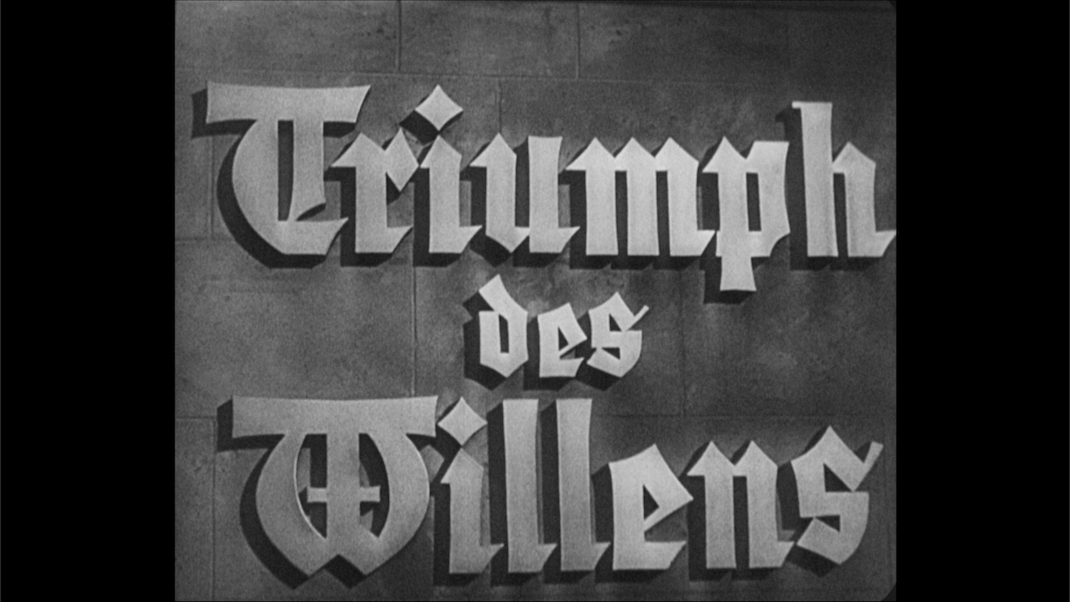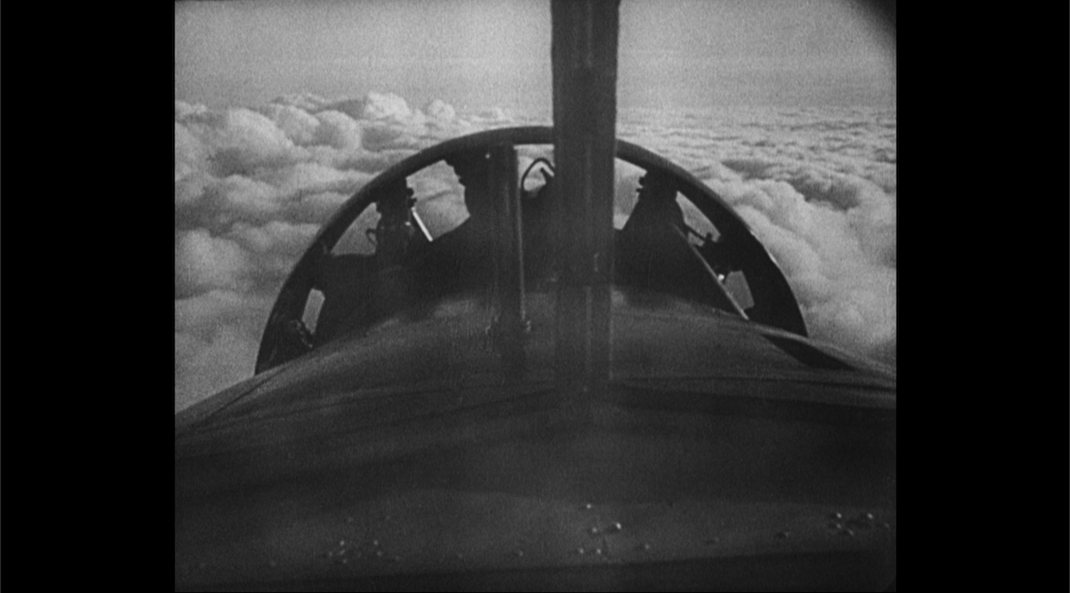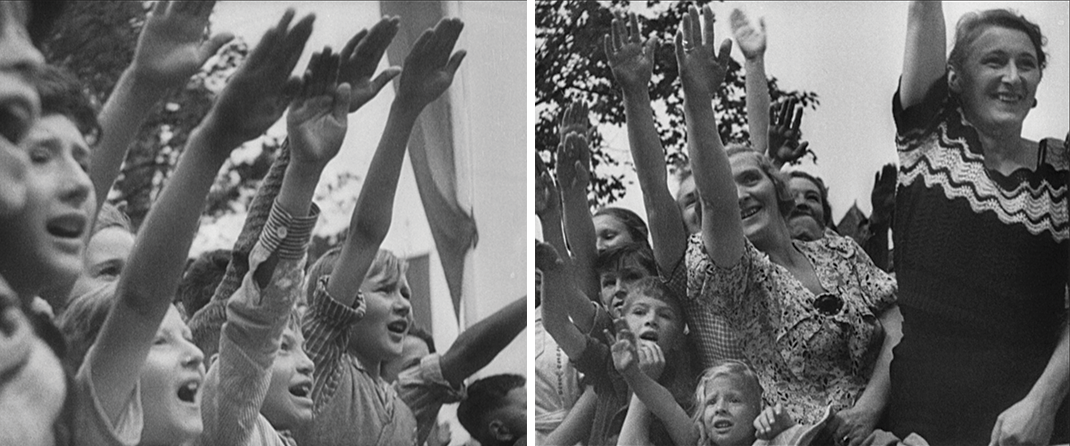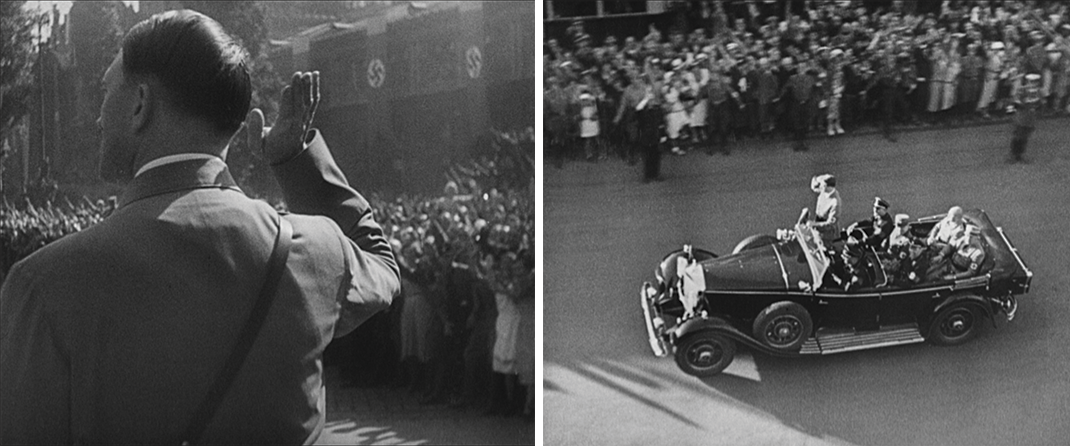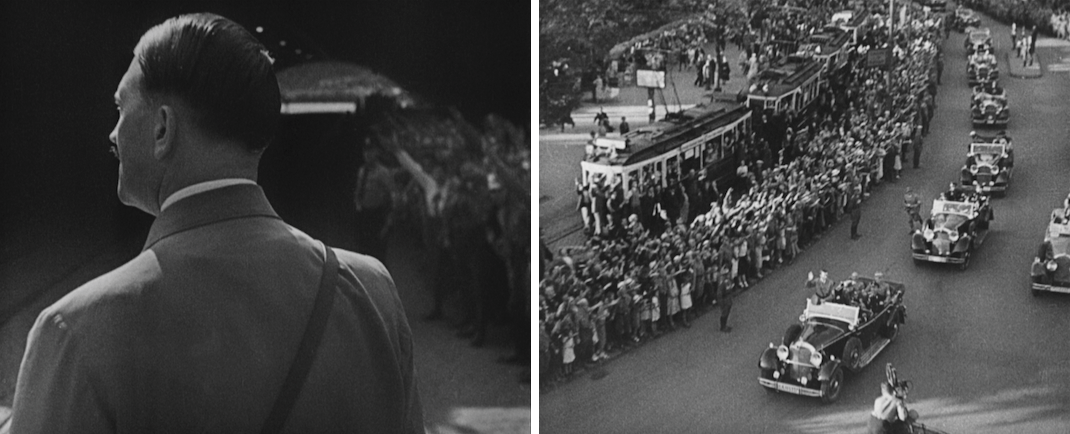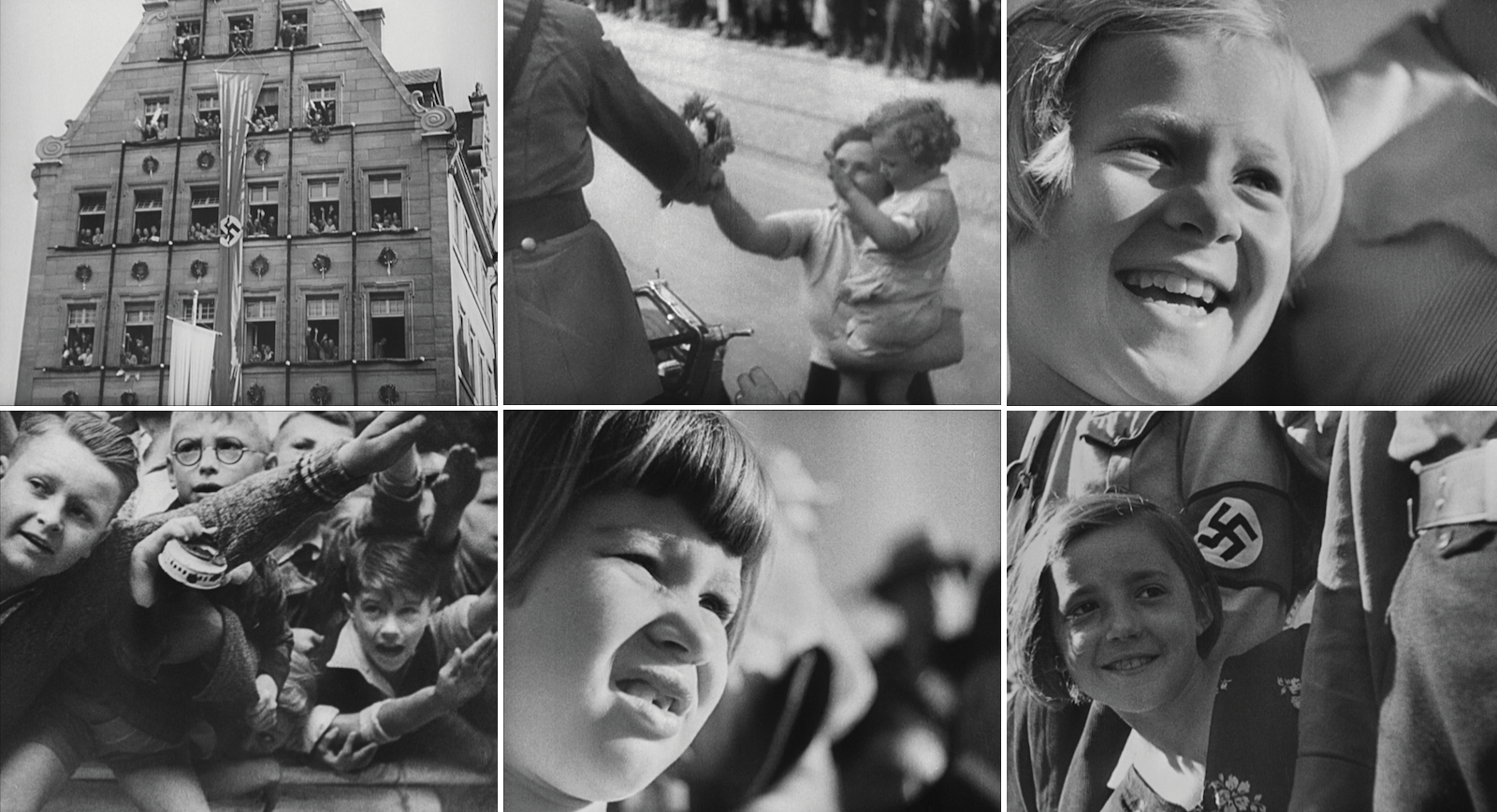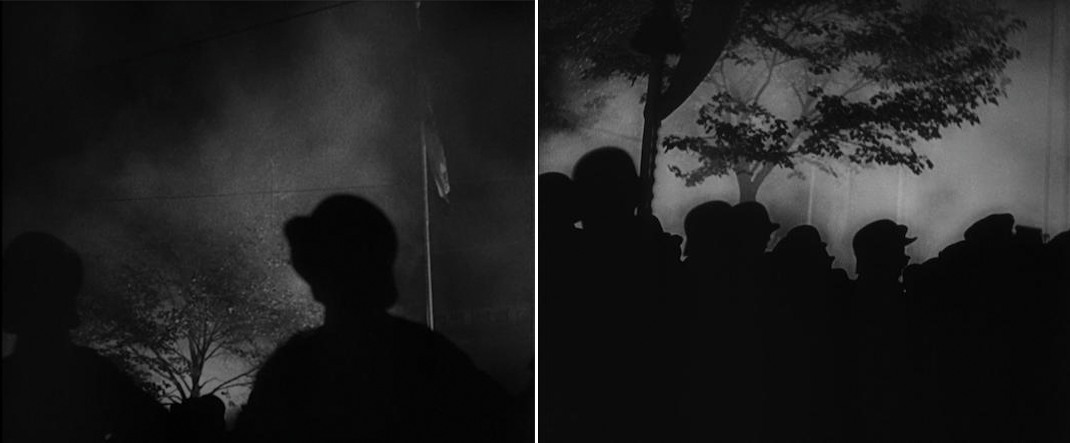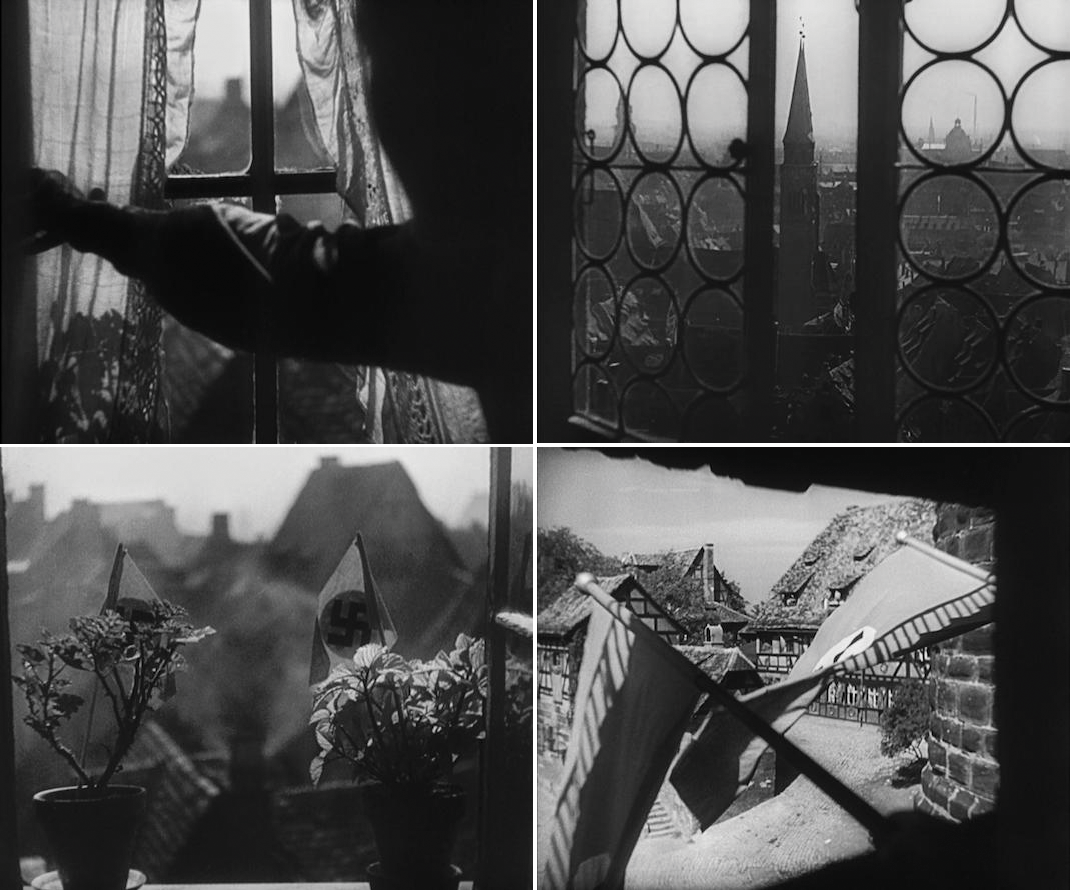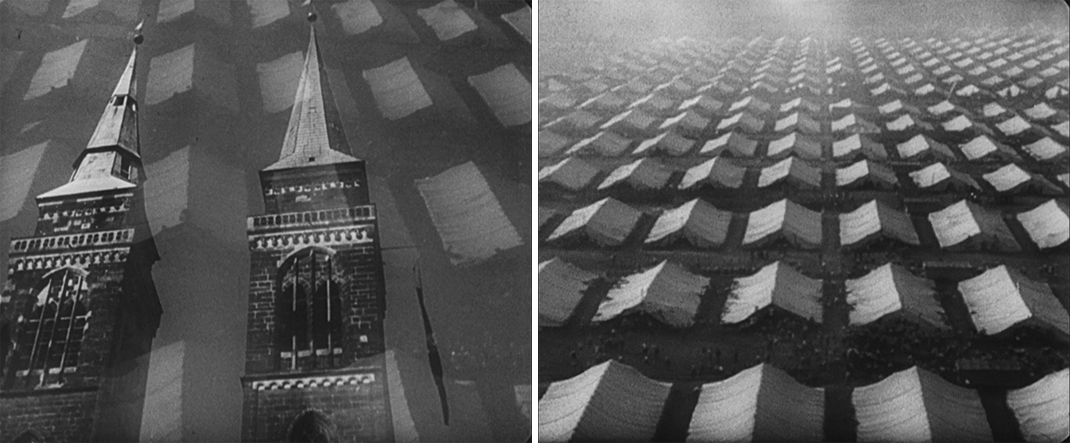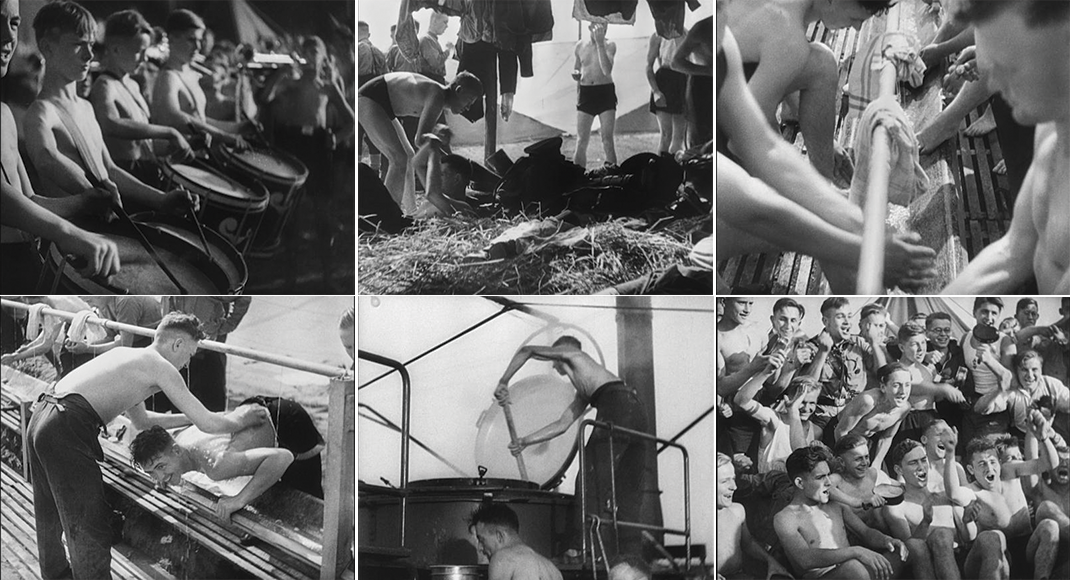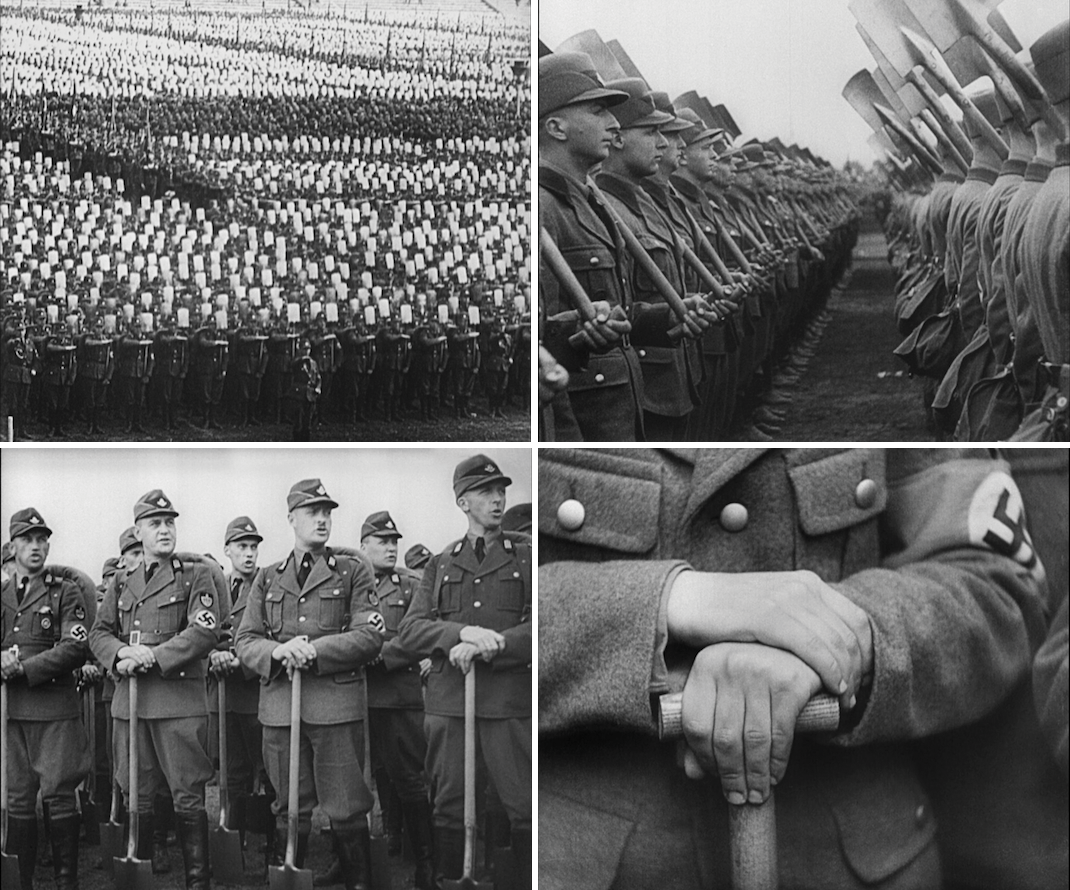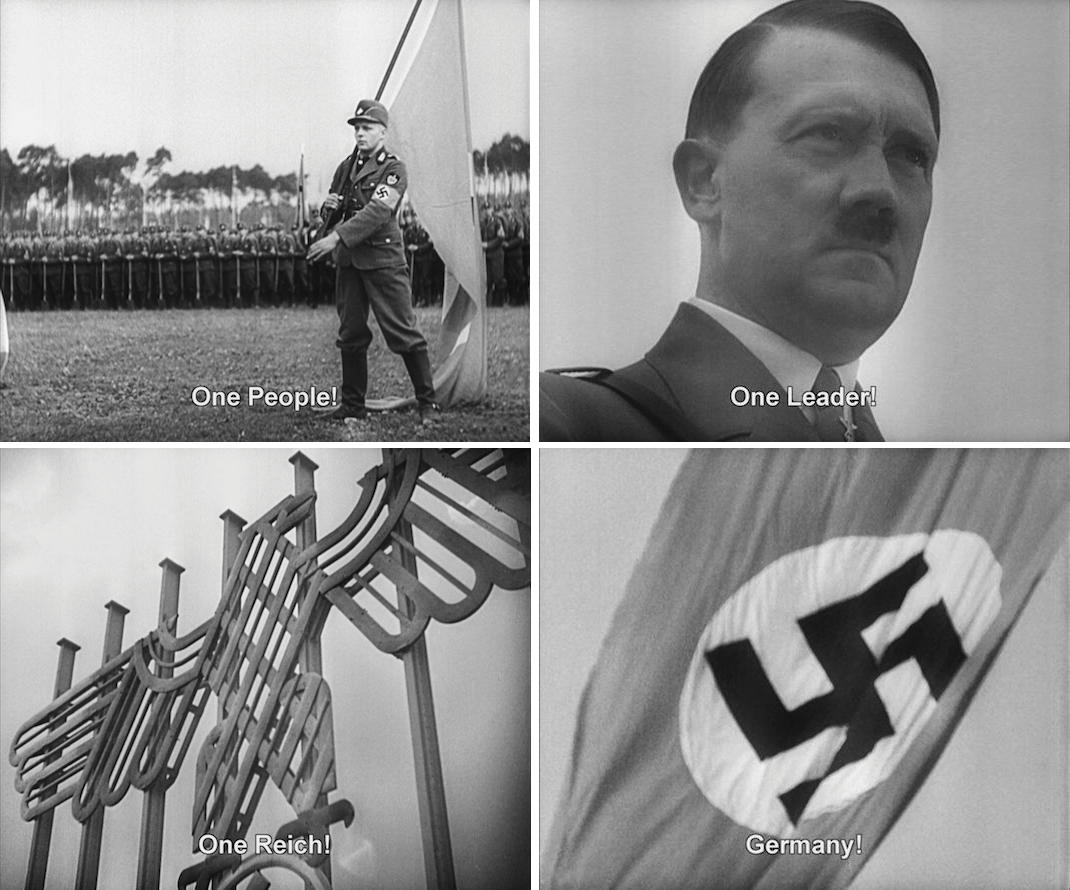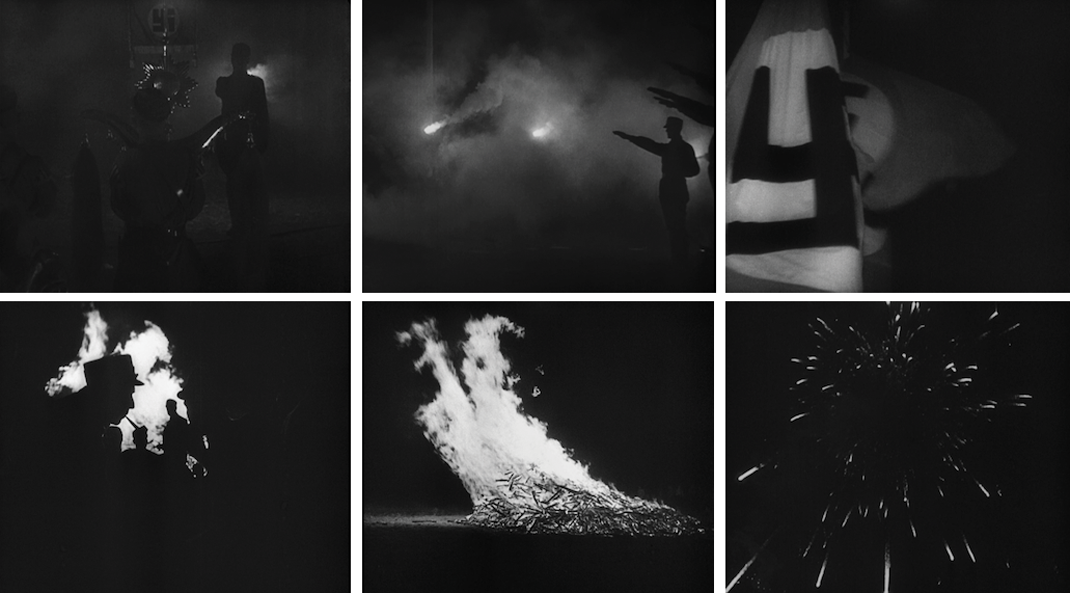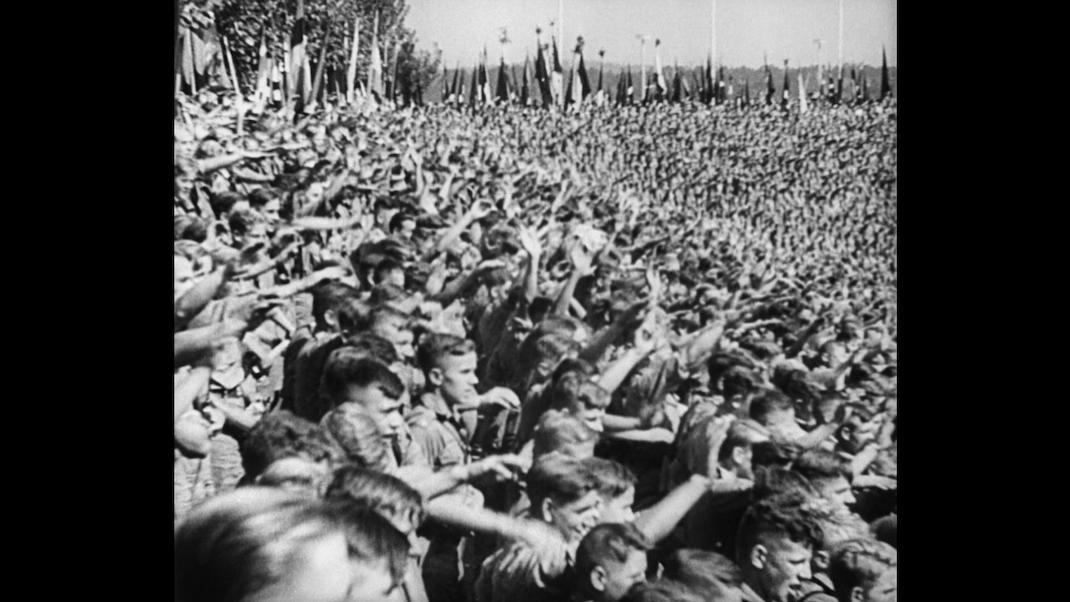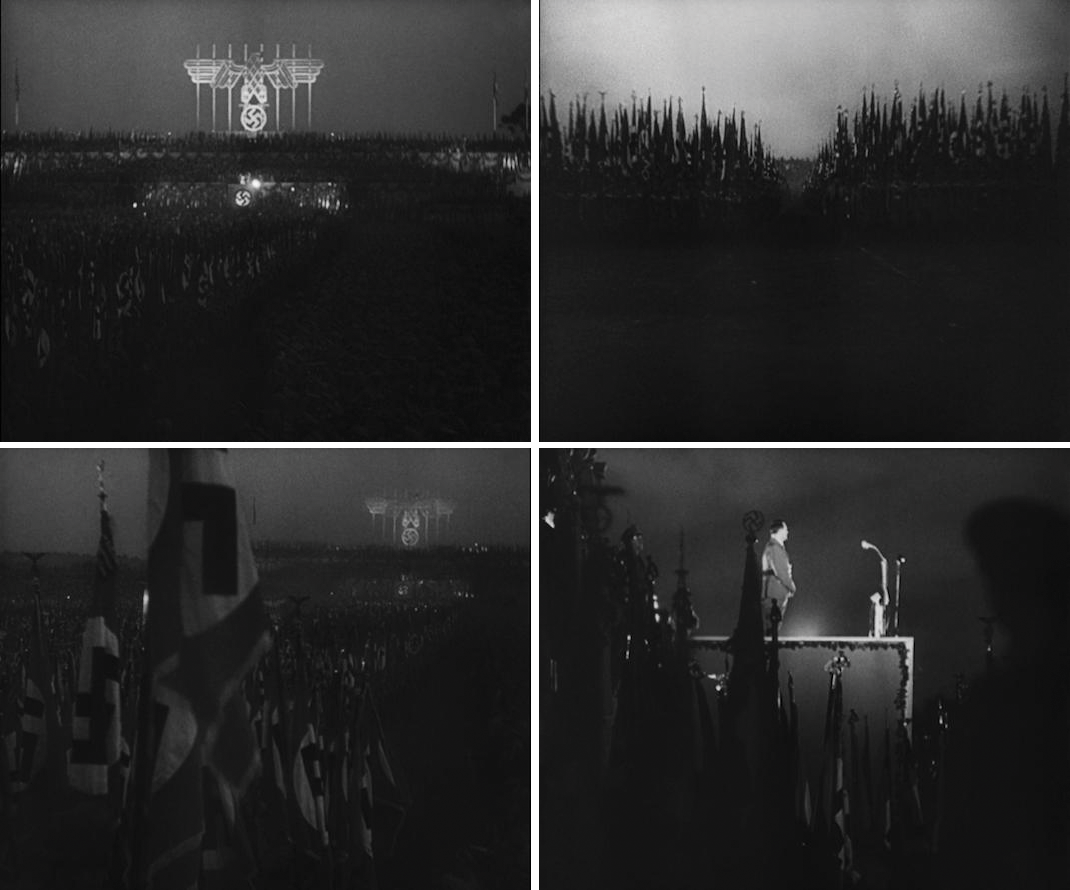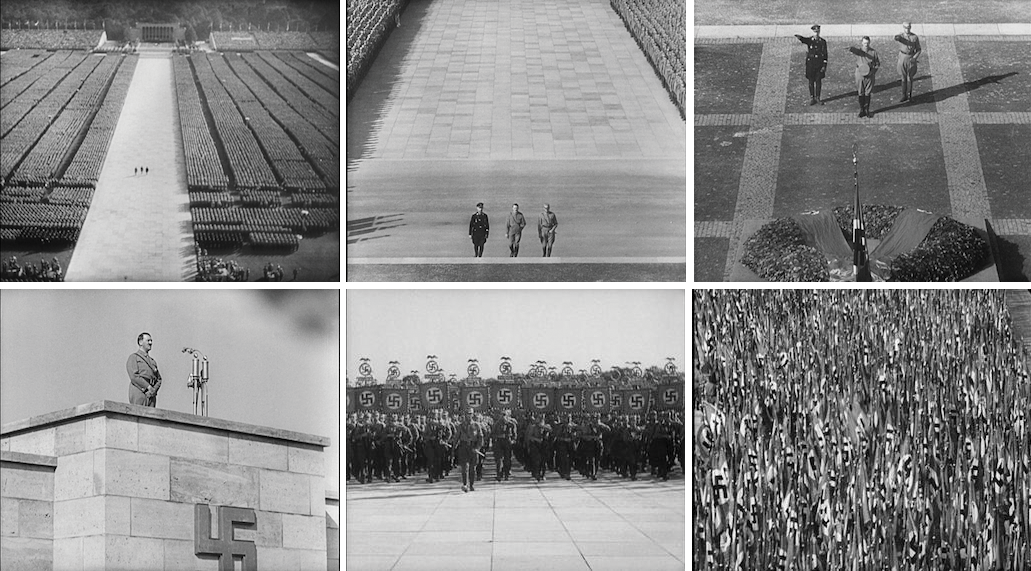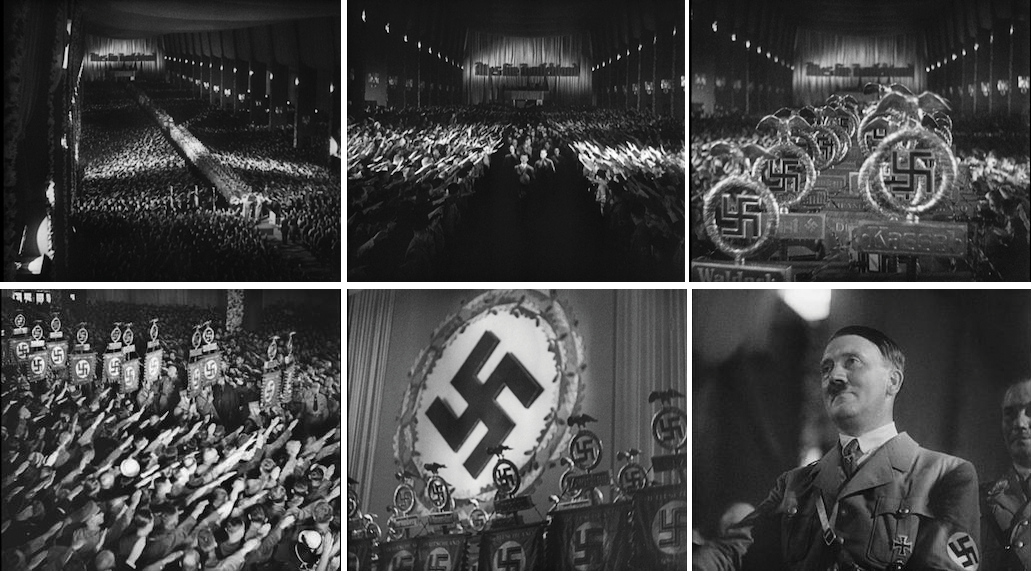In “Independent Study in World Cinema,” a self-educated film nerd attempts to fill in some fairly serious gaps in his self-education. In this tenth entry in the series, we take a timely look at Leni Riefenstahl's 1935 Nazi propaganda film, Triumph of the Will.
It would be interesting to find out how the five-year-old Nelly did not only know, but felt what the Führer was. The Führer was a sweet pressure in the stomach area and a sweet lump in the throat, which she had to clear to call out for him, the Führer, in a loud voice in unison with all the others […] Nelly could neither understand nor remember what was being talked about, but she took in the melody of the mighty chorus, whose many single shouts were building up towards the gigantic roar into which they were meant to break, finally, in a display of powerful unity. Although it frightened her a little, she was at the same time longing to hear the roar, to be part of it. She longed to know how it felt to be at one with all, to see the Führer.
—from Patterns of Childhood, by Christa Wolf1
It's funny how things work out. Well, not funny, exactly, but strange.
In February of 2016—almost exactly a year ago—I added Leni Riefenstahl's Triumph of the Will to my viewing schedule for this series. I had no hidden motive or particularly sophisticated reason for doing so: the decision came about mostly because—as I've discussed elsewhere—I realized my tentative syllabus was ridiculously heavy with male directors. I wanted to make sure I wasn't overlooking important films by women, and Riefenstahl—despite her, shall we say, troubling associations—was an obvious choice.
(As Susan Sontag points out, "Riefenstahl stands out as the only woman director who has done work likely to turn up on lists of the Twenty Greatest Films Of All Time."2 Film critic Pauline Kael called Riefenstahl "one of the dozen or so creative geniuses who have ever worked in the film medium,"3 and called Triumph of the Will and Riefenstahl's 1938 documentary Olympia "the two greatest films ever directed by a woman."4
I suspected that this post would end up being a dry, but hopefully not completely uninteresting study of innovative cinematic technique applied to political propaganda. I thought perhaps I'd end up taking a few digressions to discuss how the power of cinema can be used for both good and evil, or to blather about the ethical impossibilities of separating art from artist, or form from function.
(But what the hell did I know? I hadn't even seen the film yet.)
What I could not have known then is that my schedule would get completely derailed, and that this series would be postponed for many months. And I could not have predicted that, by the time I did get around to it, Triumph of the Will would come to have a more powerfully terrifying resonance for me than it could have had at any other point in my life.
In short, I could not have predicted—no one could have predicted—that I'd end up watching Triumph of the Will, for the first time, on the evening of Donald Trump's inauguration as President of the United States.
I'm telling you all of this not because I intend to use this piece to deliver a long diatribe about how an unfortunate percentage of my fellow Americans lost their collective minds (though they did), or because I want to write a long, impassioned jeremiad about how I fear for the future of my loved ones, my country, and my world (though I do).
Rather, I mention this because no art is consumed in a vacuum. I can't pretend to be academically objective about Triumph of the Will right now, and I don't particularly want to be. I'm going to try to discuss Leni Riefenstahl's film intelligently, but whatever analysis I do is inevitably going to be colored with the sadness, fury, and fear it evokes in me at this particular moment in history.
For Triumph of the Will is a lot of things. It is smart, it is powerful, it is beautiful, and it is evil to its absolute core. What it is not is a documentary, however often it is referred to as one of the greatest documentaries ever made. It is a lie: a carefully constructed, painstakingly orchestrated lie that became a horrifying truth, in part through the power of its own inventions.
And—just a few weeks into Donald Trump's administration of "alternative facts"—I've already seen enough of that sort of thing to last me a lifetime.
BACKGROUND
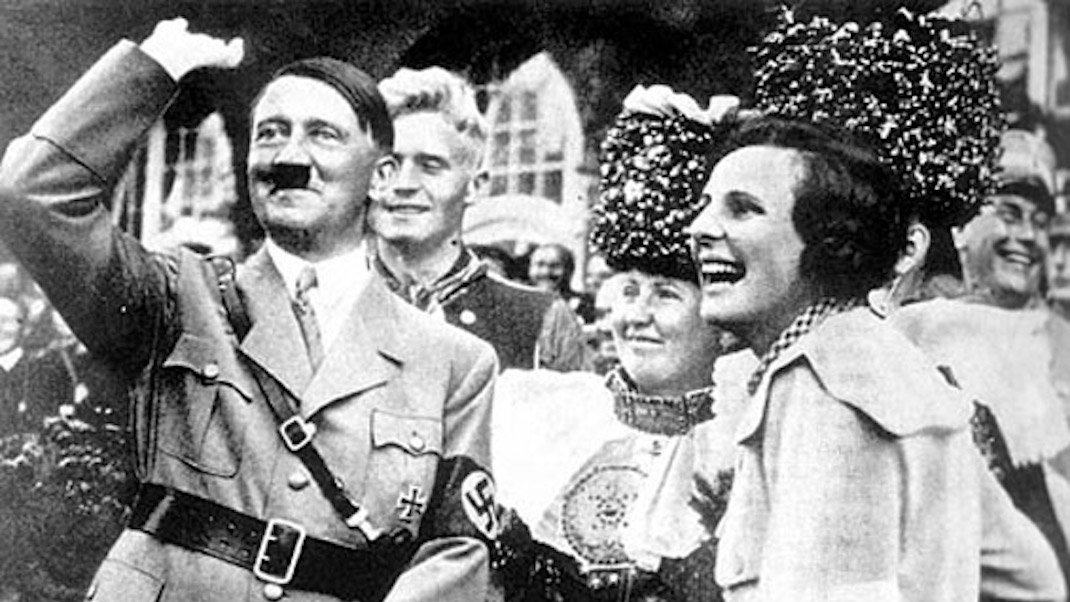
In a perfect world, any discussion of Triumph of the Will would begin with a comprehensive examination of the Nazi Party's rise to power. I have neither the space nor the expertise to provide that much background here, but a few words of (no doubt over-simplified) historical context are necessary to understand the purpose and importance of the film.
In the early 1930s, Germany was a country desperate to rebuild its economy, military, and national identity after its defeat in the First World War and a long period of economic depression under the (widely disliked) post-war Weimar government. The "National Socialist German Workers' Party" (Nationalsozialistische Deutsche Arbeiterpartei, or NSDAP), which had begun in the 1920s as a small party of thuggish, right-wing extremists, had been steadily gaining power through an extreme nationalist platform that played on desires for radical change and promised to make Germany great again. The Nazi Party told the disenfranchised people of Germany that it would bring back jobs, restore cultural values, and protect them from the Jewish, Marxist, and foreign elements that were undermining the strength of a fundamentally great nation.
This message of change and blame played well, as such messages often do. By 1932, the NSDAP held more seats in the Reichstag (parliament) than any other party. They did not, however, have a clear majority in the multi-party Reichstag, leading to something of a political stalemate between the Nazis and the more moderate or progressive factions. In January 1933, the aging president, Paul von Hindenburg, had bowed to political pressure and reluctantly named NSDAP leader Adolf Hitler as chancellor, or head of the parliamentary government.
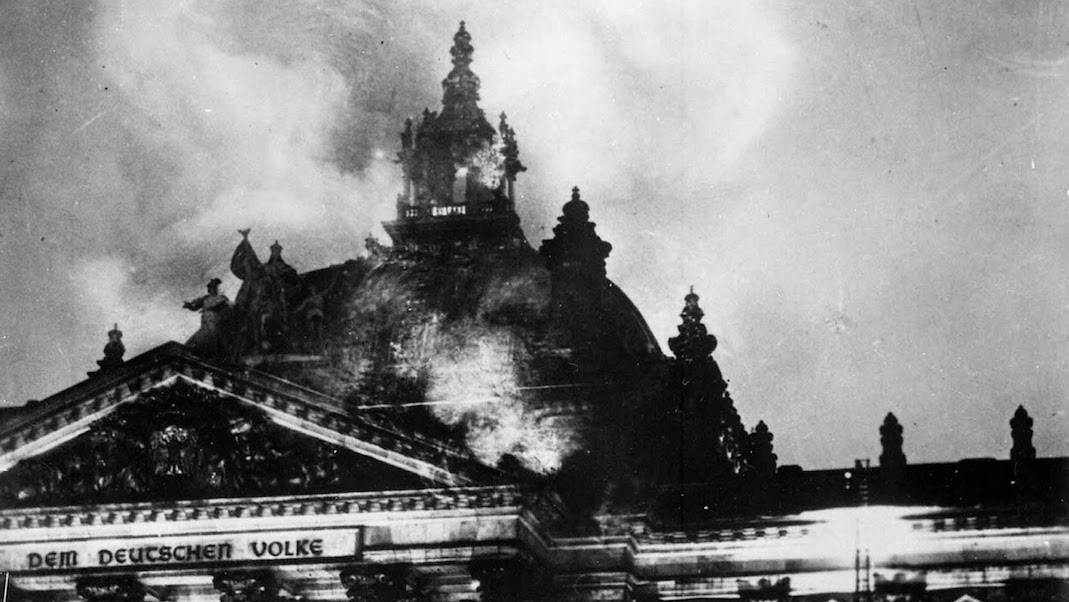
Frustrated with political opposition that slowed his agenda, Hitler unsuccessfully attempted to persuade Hindenburg to dissolve the Reichstag altogether. Then, in February of 1933, the Reichstag building was set on fire. Hitler called the fire a “sign from God,” and a communist conspirator was arrested and executed for the crime. Many historians, of course, suspect that the Nazis set the fire themselves, as a pretext for establishing a police state.5 Either way, the fire gave the Nazis exactly the opportunity they needed: on the very next day, Hitler persuaded Hindenburg to pass the Reichstag Fire Decree, which suspended basic liberties and allowed detention without trial.
In the March election, the NSDAP increased its power in the Reichstag; though still without a clear majority, they were able to rapidly pass the Enabling Act, which gave Hitler the power to unilaterally pass laws without the involvement of the parliament. At this point, though still nominally a democracy, Germany was effectively a political dictatorship.
But there was still more consolidation of power to be achieved. The Sturbabteilung, or SA, was the brutal paramilitary organization of the NSDAP, and had played a huge role in the party's rise to power. By 1933, it consisted of over three million men, dwarfing the size of Germany's actual army. Such a separate power base was a sizable threat to Hitler's primacy, however, as the ranks of SA leadership were filled with more progressive (socialist) elements and old imperialist guard. In what came to be known as "The Night of the Long Knives"—actually three nights in June of 1934—Hitler's Schutzstaffel (SS), his personal guard/paramilitary army, rounded up and executed the more problematic leaders of the SA, including its head, Ernst Röhm. This bloody purge was the final step in establishing Hitler as the unquestioned power in Germany.
On August 3, 1934, Hindenburg—still the official president of Germany—died. Conveniently, on the day before his death, the cabinet had passed a law stating that, upon Hindenburg's death, the office of president would be abolished and its powers merged with those of the chancellor to form a new supreme leader of Germany: the Führer.

What I think is important to understand about all of this, for our purposes, is that, in 1934, Hitler had seized complete control of the German government and military, but this was still a relatively new, drastic development that had come about rapidly through a series of controversial and shocking moves. The NSDAP never had a majority-elected government (until after 1934, when they began running unopposed). The recent bloody purge of the SA had horrified many within and outside of Germany, and Hitler's support from the surviving members of the SA was understandably tentative. Civil liberties—which had been fairly liberal during the Weimar Republic—had been suspended. The president was dead, and an entirely new, all-powerful position had been created and ratified through a strong-armed public referendum.
So, the final step was to convince the German people that all of this constituted the greatest thing that could possibly have happened to them. In the words of Joseph Goebbels, Hitler's Minister of Popular Enlightenment and Propaganda, "Power based on guns may be a good thing; it is, however, better and more gratifying to win the heart of a people and to keep it."
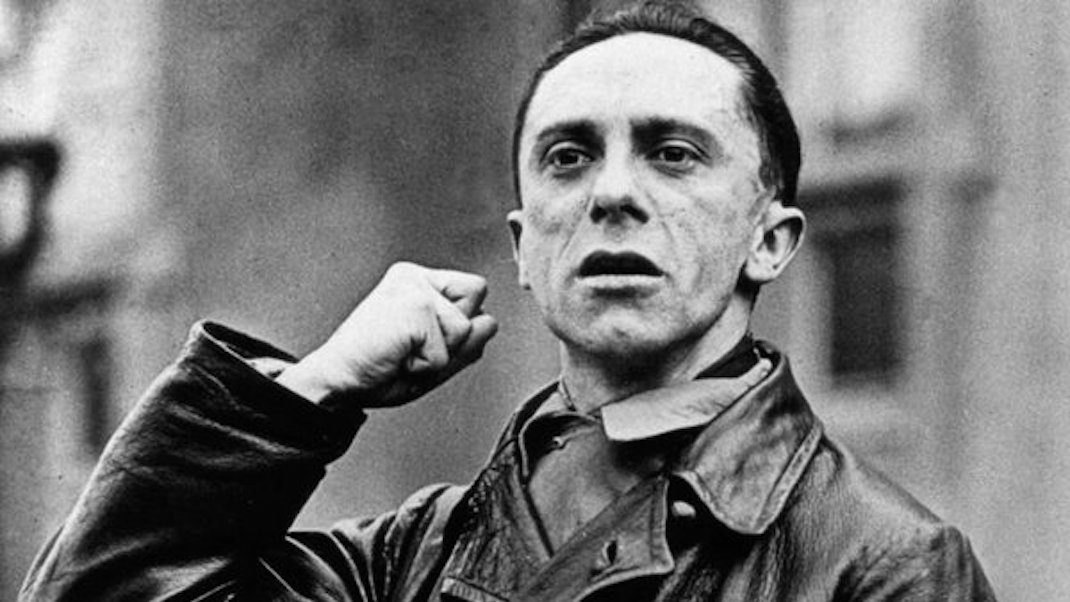
In attempting to grasp the importance of Triumph of the Will—and in further attempting to wrap our modern heads around the question of how an entire nation could descend into insanity—it's helpful to remind ourselves of how limited the distribution of information was in the 1930s. Obviously, there was no television or internet. Radio broadcasts were controlled by a state monopoly, the Reich Broadcasting Corporation, and most Germans couldn't even afford to own a radio until the Nazis themselves pioneered affordable models for propaganda purposes.6 When Hitler came to power as chancellor, the Nazis controlled less than three percent of the nation's 4,700 newspapers, but that swiftly changed: the Reich Press Law of October 1933 stipulated that all editors must be of Aryan descent, and forbade any content that would "weaken the strength of the German Reich." By the height of the Nazis' power, Goebbels oversaw over 3,600 newspapers, and editors gathered every morning at the Ministry of Propaganda to be told what they could and could not print.7
And then there was the cinema. In Mein Kampf, Hitler had discussed the power of films to reach the "mentally inert" masses:
One must also remember that of itself the multitude is mentally inert, that it remains attached to its old habits and that it is not naturally prone to read something which does not conform with its own pre-established beliefs […] The picture, in all its forms, including the film, has better prospects. Here there is less need of elaborating the appeal to the intelligence. […] In a much shorter time, at one stroke I might say, people will understand a pictorial presentation of something which it would take them a long and laborious effort of reading to understand.8
When we discussed Sergei Eisenstein's Battleship Potemkin, I mentioned how Vladimir Lenin had recognized the power of film as a means of persuading and controlling the people. ("You must remember always that of all the arts the most important for us is the cinema," Lenin said.) The Nazis were so impressed with the persuasive powers of Battleship Potemkin, in fact, that Heinrich Himmler, head of the SS, forbade his troops from seeing it.
But Goebbels—though his politics could hardly be further from Eisenstein's—wanted Nazi Germany to produce films of similar aesthetic and political power. In his first speech to German filmmakers after becoming Minister of Propaganda, in February of 1933, Goebbels had called on them to take their lead from Battleship Potemkin:
"It is a fantastically well-made film, and displays considerable cinematic artistry. The decisive factor is its orientation. Someone with no firm ideological convictions could be turned into a Bolshevik by this film. This proves that a political outlook can be very well contained in a work of art, and that even the worst outlook can be conveyed if this is done through the medium of an outstanding work of art."9
Guns could win power, Goebbels knew, but cinematic artistry could win the heart of a nation.
Which brings us, finally, to Leni Riefenstahl and Triumph of the Will.
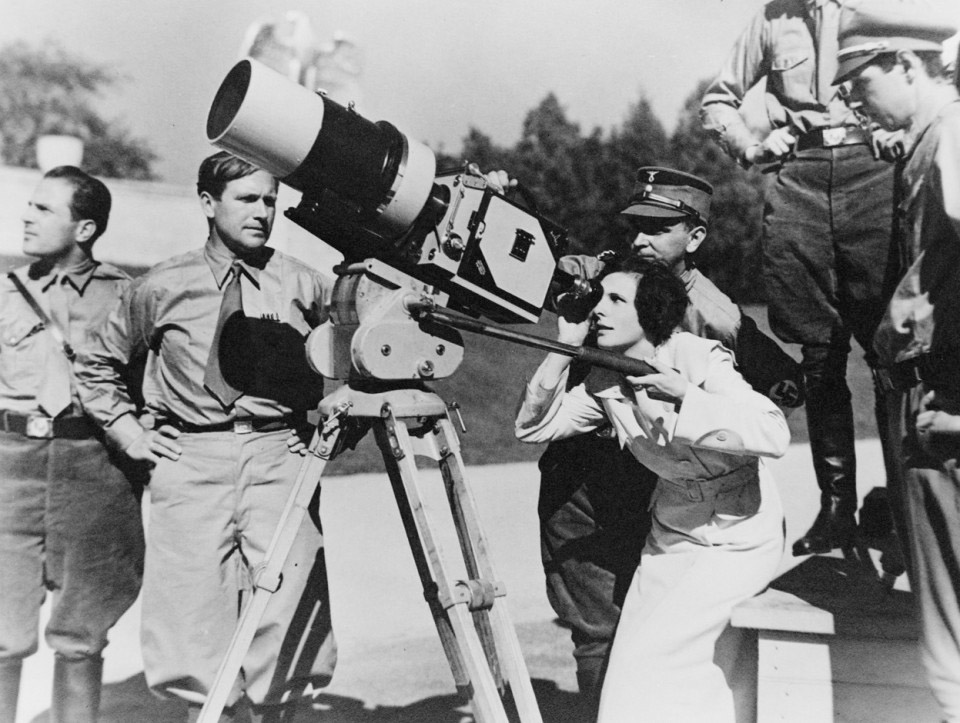
If I had the space, I could easily spend this entire post delving into the fascinating, frustrating enigma of Leni Riefenstahl, who made Triumph of the Will when she was 31 years old, and—until her death in 2003 at the age of 101—never really accepted responsibility for the role she played in advancing the Nazi cause. In the (highly skeptical) words of Clive James, Riefenstahl "never stopped denying until her long-postponed last gasp that she had ever known much about what the Nazis were really up to. She had been too busy being a great artist."10
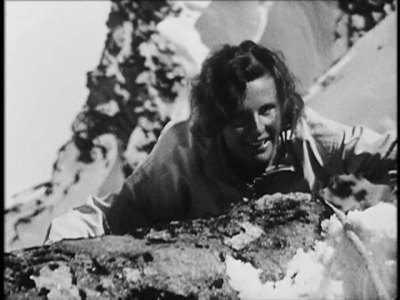
Born in 1902, Helene Amalie Bertha Riefenstahl dedicated herself to art at an early age. She painted and wrote poetry as a child, and became obsessed with dance as an adolescent. She was a star pupil at the Grimm-Reiter Dance School in Berlin, but a series of injuries hindered her intended career as a dancer and helped steer her towards the cinema. In 1926, she met Arnold Fanck, a successful director of a peculiarly German genre of cinema known as "mountain" or "Alpine" films: stories of heroic German individuals fighting for survival in breathtaking mountain locales.
Riefenstahl starred in five mountain films for Fanck: The Holy Mountain (1926), The White Hell of Pitz Palu (1929), Storm over Mont Blanc (1930), The White Ecstasy (1931), and S.O.S. Eisberg (1933). Extremely difficult to shoot, and intentionally saturated with romantic grandeur and majesty, these films no doubt provided a crash-course in the filmmaking techniques Riefenstahl would later employ in Triumph of the Will. And, as Sontag explains, many critics see these seemingly innocuous nature films as spiritual pre-cursors to a more deliberately fascist aesthetic:
Fanck’s pop-Wagnerian vehicles for Riefenstahl were no doubt thought of as apolitical when they were made, but they can also be seen in retrospect, as Siegfried Kracauer has argued, as an anthology of proto-Nazi sentiments. The mountain climbing in Fanck’s pictures was a visually irresistible metaphor of unlimited aspiration toward the high mystic goal, both beautiful and terrifying, which was later to become concrete in Führerworship.11
In 1932, Riefenstahl directed her first feature, a mystical, pseudo-religious mountain film called The Blue Light, in which she also starred. The film was not a huge success—for which Riefenstahl reportedly blamed Jewish film critics—but it was enough to impress the new Führer, who admired it greatly. (I confess, I haven't been able to bring myself to watch The Blue Light all the way through, but I've sampled it—it's currently available on YouTube here—and it is easy to see from some of its majestic shots, and its faux religious tone, how Hitler might have decided Riefenstahl was the right director for Triumph of the Will.)
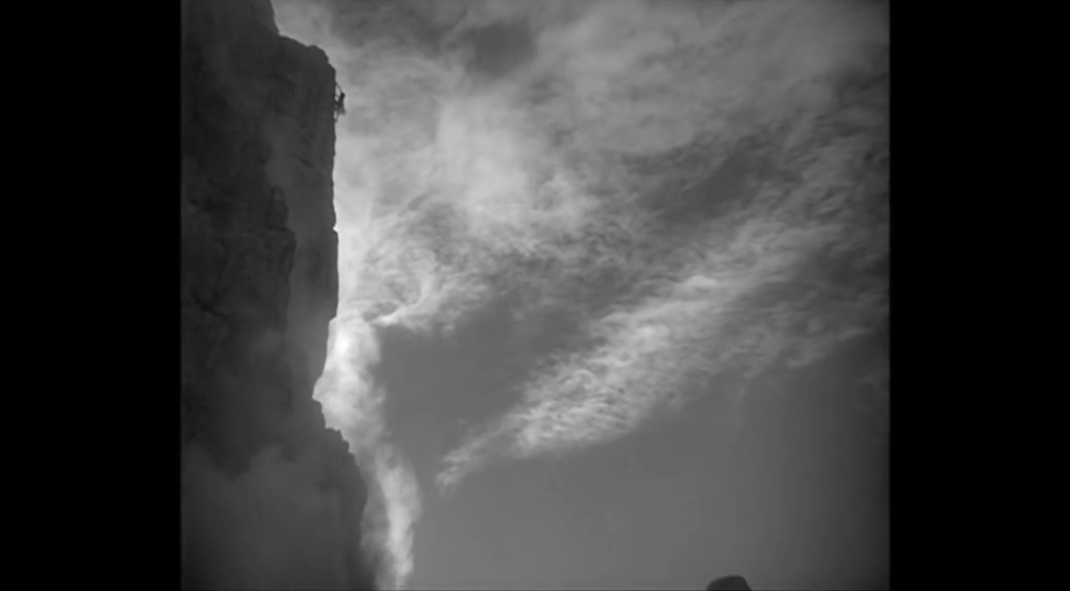
Riefenstahl had seen Hitler speak at a rally shortly before he came to power, a moment she described in her autobiography in the most rapturous of language. "That very same instant I had an almost apocalyptic vision that I was never able to forget. It seemed as if the earth's surface were spreading out before me, like a hemisphere that suddenly splits apart in the middle, spewing out an enormous jet of water, so powerful that it touched the sky and shook the earth. I felt paralyzed."12 She wrote him a gushing fan-letter, and the two began a mutually admiring correspondence. They met for the first time in person in 1932. "Once we come to power," he told her, "you must make my films."13
And so she did. Though Riefenstahl often omitted certain films from her curriculum vitae in the post-war years, the fact is that she directed six films between 1932 and the end of the war, and four of these were propaganda "documentaries" made for, and financed by, the Nazi government. The first, The Victory of Faith (1933), was an hour-long documentary of the 1933 NSDAP rally in Nuremberg. Riefenstahl encountered difficulties in filming it, and wasn't completely pleased with the finished product.
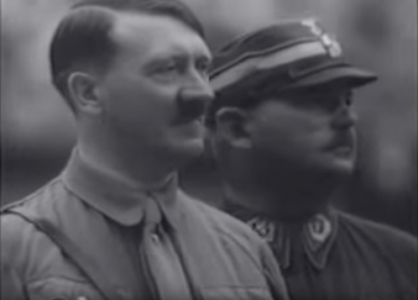
The film wasn't long for the world anyway. Since Hitler's "co-star" in this film was Ernst Röhm—the leader of the SA he ended up executing a few months later during the Night of Long Knives—Hitler ordered all copies of The Victory of Faith destroyed in 1934. The film was considered lost until a single surviving print turned up in the 1990s. Viewed today, it strikes us as a slightly lower-budget dress rehearsal for Triumph of the Will: though not as formally composed, it follows a similar progression, includes many nearly identical shots, and displays both the innovative camera techniques and overwhelming fascistic aesthetic that would mark Riefenstahl's later masterpiece.
Hitler was sufficiently impressed with Riefenstahl and The Victory of Faith that he commissioned her to film the 1934 Nazi rally in Nuremberg; this time, he offered her absolute cooperation and unlimited resources. Albert Speer, the Reich's chief architect, was enlisted to design the site for the rally: the parade grounds, lighting, and banners were all carefully planned to achieve the desired effects, and accommodations were built into the design for Riefenstahl's special camera positions. (This included an actual elevator built into the tower over overlooking the parade grounds, to enable Riefenstahl to get overhead shots.) Riefenstahl, Sontag writes, "had an unlimited budget, a crew of 120, and a huge number of cameras—estimated at between thirty and fifty—at her disposal."14
How much influence Riefenstahl had over the entire design of the Nuremberg rally seems to be a point of contention: Sontag, some historians, and, on occasion, Riefenstahl herself suggested that the entire rally was planned and staged around the movie. ("Plans for the convention were made hand in hand with plans for the film," Riefenstahl wrote in her chronicle of the film's production, published in 1935.15 Siegfried Kracauer, in his seminal book From Caligari to Hitler: A Psychological History of the German Film, argues that "the Convention was planned not only as a spectacular mass meeting, but also as spectacular film propaganda."16 Speer's memoirs, however, seem to contradict this, and some scholars have scoffed at the idea that the Reich's architect would have made such concessions to the filmmaker. ("Nor is it logical to presume that the architect of the Rallies, Albert Speer, would have altered his architectural plans for the one-shot benefit of Riefenstahl and her film crew," David Hinton writes, in response to Susan Sontag's article. "Riefenstahl filmed just one Rally in entirety; the buildings were designed to stand for centuries."17
I don't see that it matters much: everything in Nazi Germany was designed for psychological and propagandist effect, and so to attempt to separate "reality" from artifice rather misses the point. As Kracauer explains, the Nazis were determined to make the lies into truth:
Totalitarian propaganda endeavored to supplant a reality based upon the acknowledgment of individual values. Since the Nazis aimed at totality, they could not be content with simply superseding this reality—the only reality deserving the name—by institutions of their own. If they had done so, the image of this reality would not have been destroyed but merely banished; it might have continued to work in the sub-conscious mind, imperiling the principle of absolute leadership […] Proceeding ruthlessly, they not only managed to prevent reality from growing again, but seized upon components of this reality to stage the pseudo-reality of the totalitarian system.18
I can't possibly do justice to Kracauer's argument here, but what I take from it, for our purposes, is this idea of not supplanting truth with lies—which might have been seen through—but reshaping truth to conform with the lies. It is the art of transforming reality into propaganda, which can then be used to further—and more effectively—transform reality.
Aspects open here as confusing as the series of reflected images in a mirror maze: from the real life of the people was built up a faked reality that was passed off as the genuine one; but this bastard reality, instead of being an end in itself, merely served as the set dressing for a film that was then to assume the character of an authentic documentary. Triumph of the Will is undoubtedly the film of the Reich's Party Convention; however, the Convention itself had also been staged to produce Triumph of the Will, for the purpose of resurrecting the ecstasy of the people through it.19
We'll have much more to discuss about all of this—and about Riefenstahl herself—but the best way to see how it works is to look—finally—at the film itself.
THE FILM
Triumph of the Will is, as the title credits inform us, "The Document of the Reich Party Day 1934, commissioned by order of the Führer." This sub-title suggests accuracy and adherence to truth: the film, it promises, will be an official document of history.
What follows is a series of title cards, reminding us at which precise moment in history we are. "On the 5th of September, 1934, 20 years after the outbreak of the World War, 16 years after the beginning of Germany's suffering, 19 months after the beginning of the German rebirth, Adolf Hitler flew again to Nuremberg to review his faithful followers."
The first two references are self-explanatory: they are to the beginning and end of the First World War. The final one, of course, is a reference to January 1933: when Adolf Hitler became chancellor of Germany. This, the film insists, was a moment of rebirth: Hitler was the savior, arrived to deliver new life to the people of Germany after decades of misery and oppression. Even the word-choice—"faithful"—is religious, framing the Reich as a faith and the Führer as a messianic figure.
And the extraordinary opening sequence reinforces this theme in images. We begin in the clouds, flying in a world of breathtaking beauty high above the world of men. Underneath these shots, Riefenstahl has layered the Horst Wessel Song, the official anthem of the Reich. "In that moment," she said in an interview, "viewers would realize that that plane could only be Hitler's."20 Strögen's essay is highly recommended for an insightful examination of an important subject I'm going to largely ignore: the way the music functions as "commentary" for Riefenstahl's "documentary." The symbolism is obvious, but effective: this is a chariot of the gods, bringing this particular deity down from Valhalla to be among his people.
Beyond the clear symbolism, there are two elements of this I find interesting. First, there is the way Riefenstahl is careful to almost always frame parts of the airplane in her shots of the clouds. It plays, of course, to the documentary effect that was, as Kracauer argues, essential to the propagandist purposes of Triumph of the Will. The emotional effect may be magical, even intentionally supernatural, but the film always has one foot firmly grounded in reality. It feels like we are flying with the gods, but this is a real machine, built by, and carrying, men. I think this is important to the psychological intent of the film, which promised not to impose the will of the gods on the average German, but to suggest that the average German could feel like a god.
And this promise, too, is in the second aspect I find interesting in these opening sequences. Both in the sky and on the ground, we are frequently sharing Hitler's perspective. We are riding—thrillingly, with great privilege and honor—with him, as he ushers us together into this grand new age. He is not just a politician, viewed from a distance: he is the embodiment of our spirit, and he carries the hopes of a nation.
The clouds part, and the old city of Nuremberg comes into view; its gothic buildings are adorned everywhere with the both the flags of Imperial Germany and the swastika flags of the new Reich, marrying the glory of Germany's distant past with this exciting new future the Nazis were selling. (Nowhere to be seen is the flag of the recent Weimar Republic.) Riefenstahl cuts back and forth between shots of the plane and shots of thousands of people on the ground awaiting its arrival: legions of brownshirts march in perfect unity towards the plane's destination, and enormous crowds of common German people wait breathlessly for their savior and cheer his descent from the heavens.
The plane lands, and we see Hitler disembark, followed by Goebbels and other members of the Reich government. The crowd's reception is ecstatic, and Riefenstahl captures the faces of children filled with joy and hope, and the longing looks of young women gazing at Hitler with admiration and desire. For the modern viewer, it reminds us of nothing so much as footage of the Beatles arriving at JFK in 1964.
I want to reiterate again the communications environment we are dealing with here, because I think it's important. This was a pre-television age, and so—apart from newsreels—most Germans had never had the opportunity to even see Hitler, let alone experience the glory of the newly reborn Germany he promised. Triumph of the Will was designed, in part, to introduce the German people across the country to their new leaders: watching the movie would be their first real experience of the new regime.
And it is in this realization that I think we first feel the horrifyingly manipulative, sinister nature of the film. For if we accept Triumph of the Will as a documentary, it is simply capturing the natural reaction of the crowds at this moment in history. If, however, we understand its broader propagandist purposes—and understand how much deliberate craft went into its staging—we begin to see that it is also a primer: it is telling the German people, watching the film in movie houses across the nation, how they should feel, and react, and behave in response to their new leaders.
How much of the reaction captured in the film is genuine? It's impossible to say, but the cineliterate eye notices the artifice. As Hitler rides in his motorcade through the old city towards the convention site, he is, as I've mentioned, mostly filmed from behind: we are right there in the car with him, being ushered in glory towards this great new future. But Riefenstahl also keeps cutting to the perspective of the crowd, so the movie audience can experience this moment as if they were there.
Do you see the problem? Despite the fact that most of the journey is shot from just over Hitler's shoulder, wider shots reveal that there is no camera position in Hitler's car. Careful examination of this sequence reveals further such trickery. In most shots from Hitler's car, for example, it appears to be the lead car, as you would expect. But a few overhead shots capture the car just to the front and left of Hitler, with a cameraman perched on top.
From a cinematic perspective, there is nothing inherently sinister in this: this is simply how movies—even documentaries—are made. But it does beg the question of just how many times this apparently spontaneous reception in Nuremberg was staged in order for Riefenstahl to get the footage she needed. Did they make the entire trip once, shooting from the perspective of Hitler's car, and then do it again without a camera position in the car, to get the POV shots from the crowd? (One has to wonder, at the very least, how tired members of the crowd might have grown, cheering and smiling and holding their arms rigidly in the Hitler salute throughout multiple takes of this ceremonial procession.)
Since we're speaking of feigned spontaneity, I'll point out one other minor curiosity. Riefenstahl captures a passing shot of a cat, perfectly framed in a window beneath the Nazi flag, watching the Führer arrive in town. The notion that even the animals came out to worship their leader is one she must have found particularly compelling, because there is a similar—if less formally composed—shot in her footage of the motorcade from 1933's rally, in The Victory of Faith. It is all too easy to imagine that she got the shot by accident in the first film, and then carefully staged it in the second. (Any association the modern viewer makes with Art Spiegelman's Maus was probably not intended.)
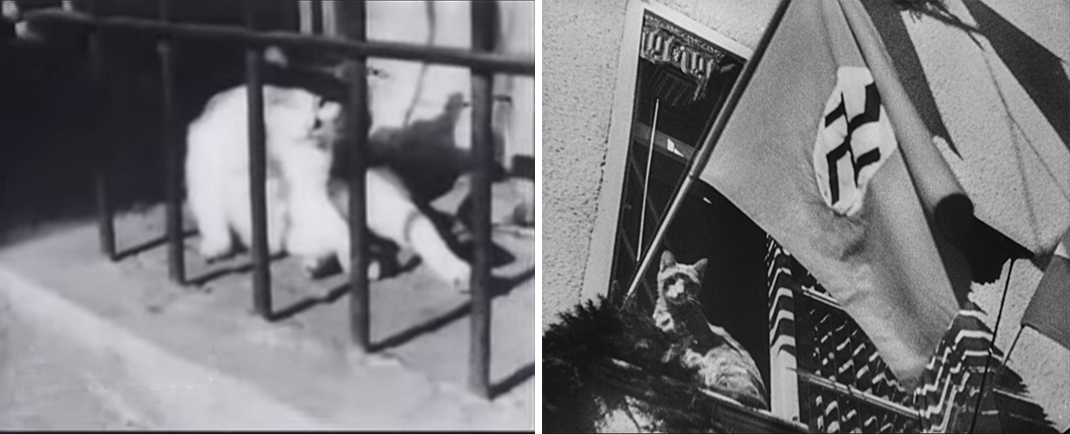
Watching Triumph of the Will now, from the perspective of history, the disconnect between its intended effect and its actual effect is almost total. Everything that was intended to be exciting is simply frightening; everything meant to seem hopeful just summons feelings of dread; all the shots Riefenstahl saturated with innocence and joy now strike us as sinister and ominous. It is impossible to look at the adoring faces of the Aryan children—who Riefenstahl fetishizes, one rushing forward to hand Hitler a bouquet—without wondering what would become of them, and who they themselves would become. One year after Triumph of the Will was made, at the next party rally, the Reich would pass the first of the Nuremberg Race Laws, stripping Jewish subjects of their German citizenship and forbidding marriage and sexual relations between Aryans and Jews to "protect the purity of the German blood." A branch of the nearby Flossenbürg concentration camp would be housed in Nuremberg during the war, using slave labor to manufacture the war machines of the Third Reich. Many of the little girls may have eventually gone to the training facility at Flossenbürg to become concentration-camp guards; most of the little boys, one assumes, joined the military and died in the war. Anyone left behind was killed or displaced in the devastating bombings of Nuremberg, from 1943–44, which destroyed 90 percent of the city. And after the war, of course, Nuremberg would be the site of Germany's reckoning with its own crimes against humanity, as the very men celebrated in Triumph of the Will were put on trial.
The sinister effect is so powerful that it almost seems intentional—but, of course, it was not. (The best we can say about Riefenstahl—and that's if we accept every one of her highly dubious post-war explanations at face value—is that she was apolitical, obscenely naive, and so focused on the form of her art that she never thought about its function.) But how ominous it seems to us, in these shots near the end of the motorcade, to see the focus slowly, almost subliminally transition from the joy of the crowds, and all the smiling faces of the children, to the stern and forbidding figures of Hitler's personal bodyguards, the SS. The black-clad figures would not have had the same evil associations then as they do now, but nonetheless this was clearly an intentional transition: from joy and hope to strength and power.
Throughout the film, Riefenstahl will make this sort of transition several times. Like the parable of a frog in slowly boiling water, the film seems designed to acclimate the German people to the new fascist aesthetic incrementally, by marrying scenes of exuberance and joy with the mindless, goose-stepping discipline that would be expected under the Third Reich. All this excitement and hope for the future, the film seems to say, must be channeled—with pride—into the carefully regimented human machinery of a powerful new Germany.
Look at the sequences that follow. We get a nighttime, army-band serenade of Hitler outside his hotel window, and an accompanying torchlight rally. Riefenstahl shows us a shot of guards pushing back against forcefully against an encroaching crowd: a massive, shoulder-to-shoulder wave of normal German citizens trying desperately to be part of the scene. (The entire sequence takes place in the shadow of a church, emphasizing the quasi-religious feeling of Führerworship.) But the most striking thing about this brief scene is the way everyone but Hitler—who stands clearly lit, above a gaudily illuminated sign reading "Heil Hitler"—is reduced to part of a faceless mass. Riefenstahl's shots, particularly of the SS guards, are beautifully composed and terrifying in their invocation of ominous, anonymous strength.
Then the next sequence opens, literally, on the dawn of a new day. Borrowing a page from "city symphony" films—particularly, Vertov's Man with a Movie Camera—we get a montage of POV shots of windows opening. The psychological effect of this is simplistic, but effective: it is morning in Germany, an awakening to a bright new future, and we are part of it.
Riefenstahl segues from the windows to a brief, travelogue-style series of glamour shots of Nuremberg, once again marrying the beauty and tradition of Old Germany with the promise of the new Reich. She lingers finally on a church, and then fades from that church directly into what the promise of Germany's future looks like: the Hitler Youth camp. Acres and acres of perfectly regimented tents, swarming with thousands of joyful, exuberant, indistinguishable Aryan boys ready to give everything for, and to, the Führer.
Throughout this following sequence, we once again see this deliberate amalgamating of promise and hope with the aesthetics of fascism. The boys are young, healthy, boisterous, and just ridiculously happy to be part of this paramilitary brotherhood. Riefenstahl fetishizes their bodies, as they begin their morning shirtless, many in their underwear: we watch them wash, and shave, and play, and begin the work of the day.
As there frequently is in fascist imagery, there is a strong hint of barely-suppressed homoeroticism in these scenes, but that's neither here nor there. What I think is important is the shameless joy of being part of the collective. Here, I think, the influence of Battleship Potemkin is clear, as these scenes call back the early scenes of the sailors operating as a happy cooperative unit in Eisenstein's film. "The individual personality, having hardly had time to become conscious of itself, dissolved in the mass," Potemkin told us, "and the mass itself became dissolved in the revolutionary élan." If the boys are not self-conscious about their bodies—and if Riefenstahl is not shy about celebrating them—it's because their bodies belong, as a collective hive, to the Reich.
(I should mention that Riefenstahl claimed, in later years, that there were no influences on her film: she said she never saw the Russian films until years later. In this, I think, we have to assume that Leni was—for neither the first or last time—simply lying. Especially given Goebbels' admiration and envy of Potemkin, it is almost inconceivable that Riefenstahl wouldn't have seen it before undertaking Triumph of the Will.)
Kracauer discusses the purpose of these sorts of scenes—of shaving, bathing, eating, etc.—in From Caligari to Hitler, as similar scenes in other Nazi-era propaganda films about the military make a point of "exhibiting what is left to the privates of their private life." As Kracauer writes:
For two reasons Nazi film propaganda thus emphasizes general human needs. First, in doing so it utilizes an old lesson taught by the primitive film comedies—that the gallery likes nothing more than the presentation of vulgar everyday procedures. […] Secondly, such scenes have the advantage of appealing specifically to instincts common to all people. Like spearheads, they drive wedges into the defense lines of the self, and owing to the retrogression they provoke, totalitarian propaganda conquers important unconscious positions.21
Riefenstahl—not for the last time in the film—pulls off a clever bit of fascistic subterfuge here. She appears to focus on individuals in the crowd, with a series of shots of obscenely happy boys. But this apparent celebration of individuality is actually just a focus on the ideal component parts of the whole: gleeful blonde Aryan boys, each thrilled to be there. The point is not to show that the crowd is composed of individuals, but to show how happy these individuals are to surrender to the crowd. (The very word "fascism" comes from the Latin fascis, or bundle: Mussolini adopted the Roman symbol of the fasces, a bundle of sticks bound together into a single unit. An individual stick is weak: a bundle of uniform sticks is strong.)
"One searches for human touches," Roger Ebert wrote, of his experience of re-watching Triumph of the Will for his "Great Movies" series in 2008. But, "Riefenstahl had no eye for human interest. Individuality is crushed by the massed conformity."22 And it's true: though the film is a stunning composite of thousands of faces and bodies, there is not a single human being who comes alive through it. There are no human-interest stories, no moments of authentic reaction, no tiny narratives of individualism of the kind even Eisenstein isolated within the "mass protagonist" of Potemkin. Nor is there, as Ebert observes, any attempt to "humanize" the unquestioned sole protagonist of the film, Adolf Hitler. A true documentary would have caught such candid moments—of weakness, or doubt, or conflict, or some emotion other than enthusiasm—if only by accident. But here, every inch of footage has been scrubbed of individual agency and personality, until only service to the Reich is left.
Ebert makes another, related observation about Triumph of the Will with which I wholeheartedly agree: it is—apart from its (considerable) cinematic and historical values—a thunderously boring film. In my viewings, I found myself struggling to reconcile these things: to pay attention to the technique, and to feel the importance, while trying not to glaze over completely from the stuporousness. As Ebert writes:
It is one of the most historically important documentaries ever made, yes, but one of the best? It is a terrible film, paralyzingly dull, simpleminded, overlong, and not even "manipulative," because it is too clumsy to manipulate anyone but a true believer. It is not a "great movie" in the sense that the other films in this group are great, but it is "great" in the reputation it has and the shadow it casts.23
Acknowledging the film's dullness—and its complete lack of any narrative drama—I'm going to skip around a bit now, and just comment on a few things that seem worth noting.
The next few sequences are designed to make the case that everyone is of value, and can be of service, to the Reich. First come the farmers, presenting their harvest to Hitler. They are dressed in traditional folk costumes, which in the context of Triumph of the Will seem like uniforms: part of the process by which the Reich instilled individual people with collective pride, and part of the process by which the film robs individuals of their identity and transforms them into objects. (To my modern, pop-culture obsessed mind, the silly costumes also remind me of the "Parade of Tributes" sequence in The Hunger Games—a frivolous, if not completely inappropriate association, given what probably happened to most of these people.)
But look how happy everyone is! Who wouldn't want to be part of this glorious celebration of a new age in Germany? Hitler loves even the common farmer! And how the common people love him: Riefenstahl intercuts these scenes with as many shots as she can find of attractive young women gazing at the Führer with wonder and longing. He's such a pin-up boy they can't even keep their tongues in their mouths.
It's hard to resist mocking, but it's probably a mistake to underestimate how effective this kind of thing was. In a theme all too familiar from our current American experience, the Nazis' popularity was largely based on playing to the class-resentments within the German working class, which had taken a beating during the depression years of the Weimar Republic. Anti-intellectualism, and the romanticizing of the common man, were the order of the day. (At the infamous book-burning in Obernplatz in 1933, Goebbels had promised that "the era of exaggerated Jewish intellectualism is now at an end. The triumph of the German revolution has cleared a path for the German way; and the future German man will not just be a man of books, but also a man of character, and it is to this end we want to educate you.")24 Here, this sequence panders shamelessly to the poor common farmers, telling them that they are important, valued, worthy of pride and deserving of the government's attention.
And the theme is furthered in the next sequence, as Hitler reviews the men of the German Labor Front. This was the national, Nazi-run "trade union" that had replaced the independent unions that had been among the first casualties in the Nazis' rise to power. (The old unions had been busted up, their assets seized, and most of their leaders arrested and sent to concentration camps. Hitler had outlawed collective bargaining, and effectively outlawed strikes and organizing.) The German Labor Front was the only union of workers, consisting of over 20 million members.
As Riefenstahl has previously focused on the individual faces of adoring children, and the individual faces of admiring women, now she singles out faces of the proud young Aryan workers. But once again, these individuals have no individuality: they are simply objectified ideals, static human symbols of the new Germany.

The following day we see the full review of the Labor Front, and it is one of the most chilling sequences in the film. Hitler addresses them, once again playing to the pride of the working class and emphasizing that they will no longer feel put upon and patronized by the intellectual elites:
"You represent a great idea […] Physical labor will no longer be a divisive concept, but it will instead bind us together. And furthermore, no longer will it be the case in German that physical labor will be seen as anything less than any other work […] The time will come when no German can be admitted into the community of the people until he has first become a member of your community."
Thousands of workers stand in formation before the Führer: they are holding shovels, not rifles, but that is the only detail that distinguishes this scene from a military review. The Treaty of Versailles had limited the German army to 100,000 men, but here we see one of the ways the Nazis got around that until they were ready to openly defy the world: they made everything a paramilitary unit, and trained everyone in unquestioning discipline and sacrifice. "We didn't stand in the trenches," these men—who were too young to serve in the last war—chant at their leader. "Still, we are soldiers…We are the Reich's young manhood!" When the war came, all they had to do was swap out their shovels for rifles.
"Comrade, where do you come from?" one of the leaders of the Labor Front calls out, and there follows a series of calls-and-responses from individual workers. "From Friesenland…From Bavaria…From Kaiserstuhl…From Pomerania…" Again, these moments of apparent individual attention serve the opposite purpose: they are intended to reinforce the collective will, to show that people from all over Germany have a role to play in the Third Reich. A young working-class man watching the film in Friesenland or Bavaria or Kaiserstuhl or Pomerania would know that he, too, had a place of pride waiting for him in the army of the Reich.
The call-outs are immediately followed with the workers chanting, in unison, "One People! One Führer! One Reich! Germany!" Riefenstahl, demonstrating—as she does throughout the film—that she learned a great deal from Eisenstein's concept of intellectual montage, punctuates each phrase with an almost static visual linking the men, to Hitler, to the symbols of the Reich.
Strötgen has a passage that seems pertinent here:
Martin Loiperdinger has thoroughly analyzed the propagandistic objective and method of Triumph des Willens in his work Rituale der Mobilmachung (Rituals in Mobilization). “Mobilization” should not be interpreted as meaning physical deployment for battle; rather, it connotes “spiritual mobilization” and refers to the psychological preparation and even rallying of the population for the coming war. “It is about inner readiness for sacrifice, including one’s own life.” The prerequisite for achieving this self-sacrificing mindset is primarily the readiness for unconditional obedience—obedience for the “political abstraction of Germany,” iconicized by the swastika and embodied in the absolutist executive power of Adolf Hitler.25
It is this spiritual preparation for war—this acclimating to, and romanticizing of—"unconditional obedience for the political abstraction of Germany"—that Triumph of the Will both captures and perpetuates. And a necessary part of this—a necessary part of any fascistic agenda—is a ritualization of war and a romanticization of death. "Comrades, who were shot by the Red Front and reactionaries," the workers chant. "You are not dead! You live in Germany."
Sontag writes:
Fascist aesthetics include but go far beyond the rather special celebration of the primitive […] They also flow from (and justify) a preoccupation with situations of control, submissive behavior, and extravagant effort; they exalt two seemingly opposite states, egomania and servitude. The relations of domination and enslavement take the form of a characteristic pageantry: the massing of groups of people; the turning of people into things; the multiplication of things and grouping of people/things around an all-powerful, hypnotic leader figure or force. The fascist dramaturgy centers on the orgiastic transactions between mighty forces and their puppets. Its choreography alternates between ceaseless motion and a congealed, static, “virile” posing. Fascist art glorifies surrender; it exalts mindlessness: it glamorizes death.26
Sontag perfectly describes the aesthetic we see throughout Triumph of the Will, with the "grouping of people/things around an all-powerful, hypnotic leader," the exaltation of mindlessness, the glamorization of death. And Riefenstahl was—without question—a master at achieving this powerful aesthetic effect. A nighttime sequence featuring a rally of the SA—whose loyalty needed to be reaffirmed after Hitler's bloody purge of their leadership and ranks—becomes a primal, tribal, almost orgiastic congregation of smoke and fire and darkness. It is horrifying, it is strangely beautiful, and (whether Riefenstahl intended this or not) it feels almost like a Satanic ritual performed in the depths of the woods in the darkest of night. This is—most blatantly, and most powerfully—the Nazi Party as mystic cult.
And a cult of death needs new recruits. From the fireworks that end the nighttime rally, we dissolve back into daylight, and the rally for the Hitler Youth.
(I have been tempted to talk about some of these scenes out of order, but, in rewatching the film, I've realized that the order is important for understanding the psychological effect of the film. Imagine being a young German lad watching this film, somewhere in the furthest reaches of the Reich. The wild, primal, forbidden male camaraderie of the brownshirts partying in the dark is appealing, intriguing, dangerous and enticing: this is the dark promise of membership in the cult. And then we see the youthful discipline of the Hitler Youth, which is the path to membership in the cult, the official entryway to the secret mysteries of manhood.)
And, though it takes place in daylight, this too is awash in mystical symbolism and religious language. Listen to Hitler's speech to the young people of Germany, one of the most passionate he gives in the film:
"You standing here today represent something that is happening all over Germany. And we want you, German boys and girls, to absorb everything that we wish for Germany. We want to be one people, and through you, to become this people. We want a society without class or rank, and you must not allow these ideas to grow within you. We want to see one Reich! And you must educate yourselves for this. We want this people to be obedient, and you must practice this obedience in yourselves. We want this people to be peace-loving, but at the same time courageous. And for that reason, you must be both peace-loving and strong. We want this people not to become soft, but to become hard, and therefore you must steel yourselves for this in your youth. You must learn sacrifice, and also never to collapse. Whatever we create today, whatever we do, will all pass away. But Germany will live on in you. And when we can no longer hold the flag that we tore from nothing, you must hold it firmly in your fists. And I know that it cannot be any other way as we bind ourselves together. For you are flesh of our flesh, and blood of our blood! The same spirit that governs us burns in your young minds. And when the great columns of our movement sweep through Germany today, then I know that you will close ranks, for we know that in front of us lies Germany, within us marches Germany, and behind us comes Germany!"
You are flesh of our flesh, and blood of our blood: the language is Biblical, drawing both on the creation story of Genesis ("This is now bone of my bones and flesh of my flesh")27 and Jesus's promise of salvation ("He who eats My flesh and drinks My blood abides in Me, and I in him").28 Hitler positions himself, rhetorically, as the film has been careful to position him visually throughout: as both God and messiah, embodying the spirit and hope of his people, handing down commandments for how they can achieve eternal life with and within him. They must offer him absolute obedience, courage, and strength: they must be prepared to sacrifice everything. This is Loiperdinger's "spiritual mobilization" for the coming war at its most manipulative and tragic, and the footage of tens of thousands of children cheering it is powerful in a way that Riefenstahl could never have intended.
The entire rally was designed to emphasize the quasi-religious, cult-like appeal of submission to the greater power of the Führer and the Reich, to the extent that we could discuss just this aspect of the film ad infinitum. There is the "cathedral of light" Speers designed for the nighttime rally on Zeppelin Field, and the "parade of flags" he envisioned for it, in which tens of thousands of men each carry the swastika flag. (This last is perhaps the perfect encapsulation of the fascist aesthetic: individual men completely lost to the fetishization of uniformity and objectification, each one turned into an abstract symbol of the Reich.)
There is the visually stunning sequence in which Hitler—flanked by the heads of the SS and the SA—walks down a long aisle between thousands of silent worshippers, to solemnly honor Germany's dead, including the recently deceased Hindenburg. Afterwards, Hitler, with great ceremony, accepts oaths of fealty from a solid stone platform—virtually an altar—specifically designed by Speer to allow this tiny man to tower majestically over his subjects.
After his speech, and after accepting their oaths of loyalty, Hitler personally hands out new flags to every regiment, and touches each new flag to the "Blood Flag"—the blood-stained flag from the failed "Beer Hall Putsch" coup attempt in 1923. The Blood Flag was one of the most sacred relics of the Reich, and here the quasi-religious symbolism becomes straight-up religion: Hitler is the high-priest, personally and ritualistically sanctifying the icons of his empire and symbolically indoctrinating the entire country into the cult of the Reich.
I have skipped over several sequences, and I will happily skip over the endless parade through the streets of Nuremberg, which takes up much of the last reel of the film. (I've always thought parades incredibly boring, and this one is more boring than most.) The best I can say of it is that Riefenstahl—credit where credit is due—gets some incredible shots. (She blatantly borrows—as she does throughout the film—from Eisenstein. Here, the shadows of the marchers echo the shadows of the Cossacks on the Odessa Steps in Potemkin, unironically glorifying imagery Eisenstein used to symbolize the brutal oppression of the state.)
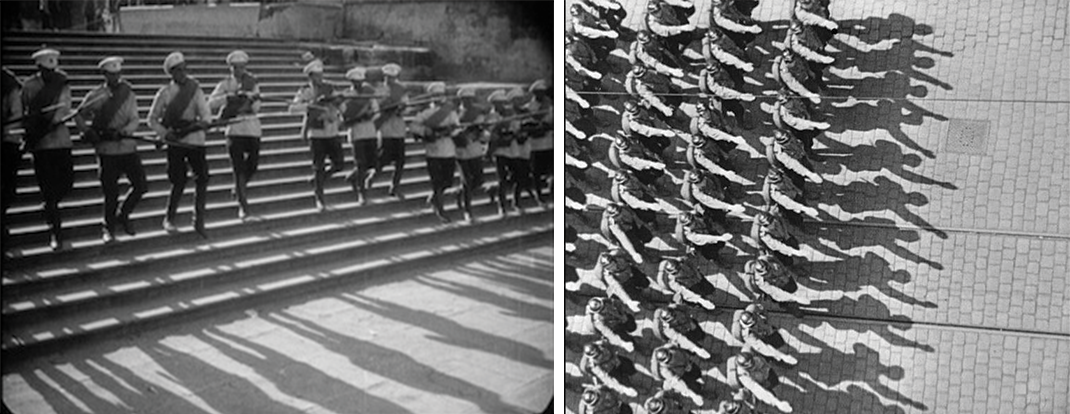
Perhaps you can tell that, by this point, I am sick to my soul of soaking in the oppressive aesthetics of Riefenstahl's masterfully-realized film. And, by this point in the proceedings, even the disingenuous glimpses of individuality we got earlier are gone: the transitional subservience that is the only "story" of Triumph of the Will has been completed, and individuality has been utterly subsumed in mass, ritualized fascism.
In the deliberately church-like atmosphere of the rally's closing ceremonies, we see only objects: fetishized banners and standards gleam with light, but human beings are reduced in the darkness to just their hands, raised into the light as they signal their submission and obedience to the Führer.
Hitler's closing speech is remarkably unremarkable. It re-emphasizes the same themes we have seen throughout. He reinforces the oppression and persecution good Germans suffered under the previous administrations, and asserts how happy the people are now that the changing and failing leadership of the nation has finally been replaced by a "fixed pole, a force which considers itself the representative of the best blood." The Party, he says, will be like a "Holy Order." All Germans must become National Socialists, and only the best National Socialists will be members of the Party. His language, as always, is simple, accessible, speaking to lowest-common-denominator intellect and appealing to base, self-aggrandizing instincts.
But, throughout Triumph of the Will, speeches—even Hitler's—are never the point. Earlier in the rally there was a series of speeches by Party officials, but Riefenstahl showed almost none of them: from each speech, Riefenstahl pulled out just a single aphoristic line or two. "You are Germany!" Hess, the Deputy Führer, says to Hitler. "What braves the centuries will also be strong through the centuries!" promises Adolf Wagner, Interior Minister. Otto Dietrich, the Reich press chief, says "Truth is the only foundation, on which the power of the press stands in the world. To tell the truth is the only demand that we place on foreign press." It is in these speeches that Goebbels delivers his line about winning and keeping the heart of the people.
And that's the point: if Triumph of the Will was—as it claims to be—"the document of the Reich Party Day," it would have made the effort to preserve these speeches for historical posterity. (The film's speeches, in fact, are more notable for what they don't say as for what they do. The word "Jew" is never mentioned, for example, and only one line remains to forewarn of the anti-Semitic agenda that had already begun setting the machinery of the Holocaust in motion: "A people that does not protect the purity of its race goes to seed!")
But Hitler and Goebbels knew that people didn't want to watch speeches. Rhetoric was not the most effective means of making converts, and—to the extent it would have engaged the rational mind of the viewer—it would actually have been counterproductive to the film's indoctrinatory mission. Propaganda, as Hitler wrote in Mein Kampf, "must appeal to the feelings of the public rather than to their reasoning powers."
All propaganda must be presented in a popular form and must fix its intellectual level so as not to be above the heads of the least intellectual of those to whom it is directed. Thus its purely intellectual level will have to be that of the lowest mental common denominator among the public it is desired to reach. […]
The receptive powers of the masses are very restricted, and their understanding is feeble. On the other hand, they quickly forget. Such being the case, all effective propaganda must be confined to a few bare essentials and those must be expressed as far as possible in stereotyped formulas. These slogans should be persistently repeated until the very last individual has come to grasp the idea that has been put forward. If this principle be forgotten and if an attempt be made to be abstract and general, the propaganda will turn out ineffective; for the public will not be able to digest or retain what is offered to them in this way. Therefore, the greater the scope of the message that has to be presented, the more necessary it is for the propaganda to discover that plan of action which is psychologically the most efficient. 29
Triumph of the Will is not a historical document, and it is not an appeal to reason or intellect. It's just the opposite: a deliberate psychological and emotional assault on the senses, a complete immersion in—and glorification of—the subservient mindset of fascist ideology. As Goebbels had said in 1933:
"This is the secret of propaganda: to totally saturate the person, whom the propaganda wants to lay hold of, with the ideas of the propaganda, without him even noticing he is being saturated. Propaganda has of course a purpose, but this purpose must be disguised with such shrewdness and virtuosity that he who is supposed to be filled with this purpose never even knows what is happening."30
Triumph of the Will is the propaganda of saturation: it does not argue its vision, but manifests that vision as an experience that could be delivered, in all its sinister ecstasy, to the masses in compelling, almost hypnotic form. Whatever her intentions, Riefenstahl indeed understood her art, putting the almost subliminal power of cinema to a purpose that borders on emotional brainwashing. As Kracauer says:
This film represents an inextricable mixture of a show simulating reality and of German reality maneuvered into a show. Only a nihilistic-minded power that disregarded all human values could so unhesitatingly manipulate the bodies and the souls of a whole people to conceal its own nihilism.31
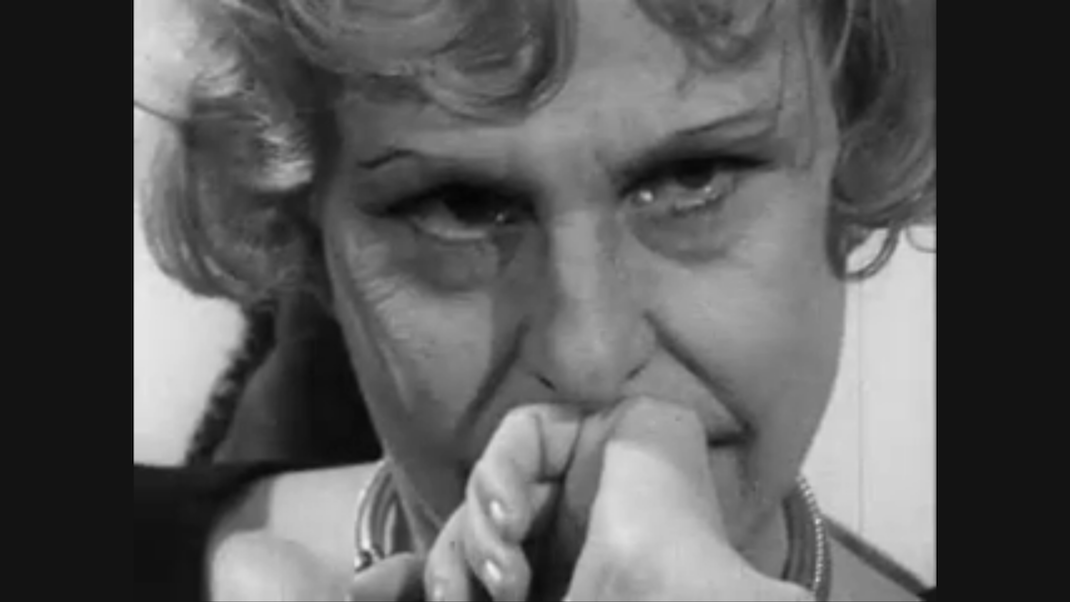
How, then, are we to judge Leni Riefenstahl? I had intended to spend more of this post discussing her strange life and analyzing her complicated legacy. There is the juicy gossip of her private life. (Were she and Hitler lovers?) There are problematic incidents of anti-Semitism and complicity with the Nazi agenda that belie her frequent claims of apoliticism and naïveté. (She had the names of her Jewish writer and producer removed from The Blue Light. Years later, while filming one of her non-state-sponsored films, she was loaned more than 90 "extras" from a nearby concentration camp.) After the war, the Allies arrested and held her for some years, but eventually released her, unable to come to a decision about whether filmmaking could constitute a war crime.
And, in viewing Riefenstahl as a female director, there is rampant sexism that's worth noting, an unfortunate tendency to demean and dismiss her considerable skills as a filmmaker. In my readings about her, I have seen constant discussion of her looks, and rampant speculations about her sexual appetites. There is a prevalent desire to attribute the extraordinary formal composition of Triumph more to Albert Speer than to Leni Riefenstahl. In one instance, I even came across a staggeringly sexist suggestion that she could not possibly have been responsible for the masterpiece of editing that is Triumph of the Will. (Director Walter Ruttmann—who had worked on The Victory of Faith, and was originally involved in plans to shoot the 1934 rally—had no documented role in Triumph of the Will, yet historian David Culbert seems to believe he somehow deserves all the credit. "Ruttmann's role in editing Triumph of the Will is unclear, but his genius in the area of film montage is a matter of public record; it is much more plausible that he worked on editing Triumph of the Will than the presumption that a beautiful actress suddenly took up the complicated art of montage and achieved such extraordinary results.")32 Few critics and pundits seem to be able to resist innuendo, or the urge to dismiss her as "Hitler's handmaiden," a sinisterly ambitious sycophant. "Luckily for her, she had feminine wiles to burn," Clive James writes. "It could be said that she had looks and energy but no real brain. The evidence was overwhelming that she didn’t need one."33
And so the impulse to defend Riefenstahl—if only from these sexist disparagements of her talent—is strong, and she definitely has her defenders and apologists. "Can't we say that every film is propaganda?" asks film critic Richard Corliss, who also observes that "Many fine filmmakers have worked under dictatorships."34 (It's a facile point, but not a completely irrelevant one: do we blame Eisenstein for the crimes of Stalin?)
Leni Riefenstahl's biggest defender, of course, was Leni Riefenstahl. She offered many, often conflicting explanations and rationalizations about her time spent in the Third Reich. She said she had "no political reasons for making these films. There was one Hitler and one government. Everyone shouted: 'Heil Hitler.' It was normal at that time. You have to put yourself in the past to look at it from the right perspective."35 "I just made it the way one makes anything," she said in one interview. "I never thought what kind of effect the images might have." In another interview, she claims she was "forced" to make the film: "It was pure torture having to make that film." In one interview she might claim that Goebbels hated her, even sabotaged her, and that he put her film to propaganda purposes that she never intended. In another, she would boast that Goebbels admired her greatly, and wanted to make several more projects with her.
She never relinquished her admiration of Hitler, or denounced her friendship with him, but she expressed horror at the things that he did, and the things that were done in his name. She always made a point of saying that, at the time, she had no way of knowing what the Third Reich was all about:
"I've never understood why I have been attacked and shunned so much here in Germany, indeed the exact opposite of the positive things the same people said about me before the war ended. It was the same people who wrote enthusiastically about Triumph of the Will before the war or awarded it prizes. After the war they demonized my films and labeled them as witchcraft. My films were looked at through extremely political lenses. After the war the people were as if paralyzed by the terrible things, completely understandable […] I was also as if paralyzed, and I saw those things as if through a different set of glasses, in a different color, and everything seemed very dreadful. Of course, before that, we weren't informed about Hitler's concentration camps, at that time one was still very impartial and saw only Hitler's positive achievements. However, as it later became known what terrible things happened in his name and his Party one was appalled, very deeply and rightfully appalled. That was an enormous change in our knowledge.[…] After the war, I was greeted with fabrications and considered as a reject from humanity […] I was made out to be a monster, maybe because I was a woman, or perhaps because I had made more famous films, so that envious persons came on the scene. The newspapers wrote, 'Should we let her live?' or, 'Shouldn't she be on trial in Nuremberg too?' I was suddenly slandered as a super-Nazi, as a leader who, like Joan of Arc carrying the flag, marched the troops to victory at Orléans. That's how I was denounced as a monster."36
She spent her life after the war trying to rehabilitate her image, but her film career was over: in 1954 she managed to finish and release a film she had begun many years earlier, Tiefland, but it met resistance from the industry and had little impact. It was her last feature film. In her later years, she became a photographer and nature documentarian, releasing several books of photographs of African tribes, and a documentary of ocean life, Underwater Impressions, shortly before her death.
She fought—and won—several court cases accusing her of collaboration. She lived to 101, and outlived everyone who could counter her self-rationalizations or substantiate her murky recollections. She said she regretted making the films for the Nazis, but her regret always seemed to be for the troubles the films caused her, not for the part she played in advancing and advocating the genocidal, world-dominating ambitions of the Third Reich.
Me? I find, at the end of this long, deeply unpleasant journey with Triumph of the Will, that I don't particularly care whether Leni Riefenstahl was just an apolitical, "arts-for-arts-sake" formalist, or a monstrous true believer in the fascist world that her friend Hitler came perilously close to achieving. Certainly, it is difficult to watch the masterfully, precisely composed scenes of Triumph of the Will and believe that Riefenstahl could have been somehow ignorant of the terrifying agenda she was serving so effectively. At best, we can suppose that she was—like millions of her fellow Germans—so duped by the promise of change and prosperity that she ignored the overwhelming evidence of her own camera.
I suppose Riefenstahl was a genius, if only of a technical, and not a visionary, kind: I certainly have no desire to watch any more of her films, and I guess if you pushed me I'd say that she probably got the life and reputation she deserved. She probably shouldn't have been hanged for her crimes, but I'm glad the world of cinema shut her out so completely. A genius with no conception or concern for how their art is being used seems almost as dangerous and reprehensible to me as one who consciously uses their art for evil. Riefenstahl was definitely one or the other, and she may—at various times—have been both. There is not a director, alive or dead, whose work I find beautiful enough that I would forgive them for a film like Triumph of the Will.
I began this post talking about the inauguration of Donald Trump, and it occurs to me now that I haven't said much about that. On the other hand, I feel like I've been talking about little else but that: the promise to restore a nation to "greatness"; the jingoistic, lowest-common-denominator language; the stubborn adherence to debunked lies over proven truths; the pandering to the working class, with false and empty promises of prosperity; the aggressive seizing of power through emergency measures, with a blatant disregard for constitutional checks-and-balances; the strong-arm tactics to control the media and make them print only your message; the constant disparagement of reason and intellectualism; the horrifying demonization of other cultures to provide an enemy and an excuse; and all of it wrapped in the simplistic, catering, cultish symbols of patriotism. The comparisons are imperfect, as the players are different, the times are different, the countries are different, and (I like to believe) the American people are different. But the similarities are nonetheless profoundly disturbing, and they have made Triumph of the Will feel, at this moment in history, less like a historical curiosity, and more like a cautionary tale.
And so, on that note, I'll give Leni Riefenstahl the last word:
"Look, I was living in Germany in this time. If you remember, 90 percent of the people are enthusiastic in this time. We have 7 million people without work, and so we had thought it would be better and better. We are not thinking about what could happen later. That was really our mistake, not to think so. But I think millions of people have done it."

Next on the Syllabus
We happily turn our attention to two of the universally acknowledged greatest films of all time, from French master Jean Renoir: Grand Illusion (1937) and The Rules of the Game (1939). For those of you trying to watch along, both are available as streaming rentals on Amazon (though I can't vouch for the versions).
Notes
- Christa Wolf, Patterns of Childhood, translated from the German by Ursule Molinaro and Hedwig Rappolt (New York: The Noonday Press, 1980), p. 45.
- Susan Sontag, “Fascinating Fascism,” New York Review of Books, February 6, 1975.
- Quoted in Steven Erlanger, “Still Making Films, Still Explaining the Hitler Connection,” New York Times, January 8, 2002.
- Pauline Kael, 5001 Nights at the Movies, (New York: Henry Holt & Co., 1982), p. 544.)
- See Tony Patterson, “Historians find ‘proof’ that Nazis burnt Reichstag,” The Telegraph, April 15, 2001.
- See “Hitler’s Radio” by Glenn Aylett, at transdiffusion.org.
- For this overly brief summation, I’ve drawn from “The Control of Press, Radio, and Films” on erenow.com; “The Press in the Third Reich” entry in the Holocaust Encyclopedia; and “Newspapers in Nazi Germany” on The History Learning Site.
- Adolf Hitler, Mein Kampf (p. 339). UNKNOWN. Kindle Edition.
- Quoted in Richard Taylor’s Battleship Potemkin: The Film Companion (London: I.B. Tauris, 2000), p.112.
- Clive James, “Reich Star,” New York Times Book Review, March 25, 2007.
- Sontag, ibid.
- Quoted in Alan Riding’s “Leni Riefenstahl, 101, Dies; Film Innovator Tied to Hitler,” New York Times, Sept. 10, 2003.
- Ibid.
- Sontag, ibid.
- Leni Riefenstahl, “Behind the Scenes of the National Party Convention Film” (Munich: Mueller and Son, 1935); English Language Facsimile Edition translated by David Culbert (Chicago: International Historic Films, Inc., 2010), p. 31.)
- Siegfried Kracauer, From Caligari to Hitler: A Psychological History of the German Film. (Trenton: Princeton University Press, 1966, first published 1947), p. 301.
- David Hinton, reply by Susan Sontag, “An Exchange on Leni Riefenstahl,” New York Review of Books, September 18, 1975.)
- Kracauer, 298–299.
- Kracauer, 301.
- Quoted in Stefan Strötgen, “‘I compose the Party Rally…’: The Role of Music in Leni Riefenstahl’s Triumph of the Will,” Music & Politics, Vol II, Issue 1, Winter 2008.
- Kracauer, 284-5.
- Roger Ebert, “Triumph of the Will,” rogerebert.com, June 26, 2008.
- Ebert, ibid.
- “Book Burning — Historical Film Footage, Germany, May 10, 1933,” Holocaust Encyclopedia.
- Strötgen, ibid.
- Sontag, ibid.
- Genesis 2:23.
- John 6:56.
- Hitler, pp.135–6.
- Joseph Goebbels, Address to radio stations, March 25, 1933. Quoted in Paul Watzlawick’s essay “Self-Fulfilling Prophecies,” in The Production of Reality: Essays and Readings on Social Interaction, 4th Edition, edited by Jodi O’Brien (Los Angeles: Pine Forge Press, 2006), p. 392.
- Kracauer, 303.
- David Culbert, Leni Riefenstahl’s Triumph of the Will (University Publications of America, 1986), p. 3.
- James, ibid.
- Richard Corliss, “That Old Feeling: Leni’s Triumph,” Time Magazine, August 22, 2002.
- Quoted in Luke Harding, “Leni Riefenstahl, Hitler’s favourite film propagandist, dies at 101,” The Guardian, Sept. 10, 2003.
- Leni Riefenstahl, Interviewed by Die Welt.

